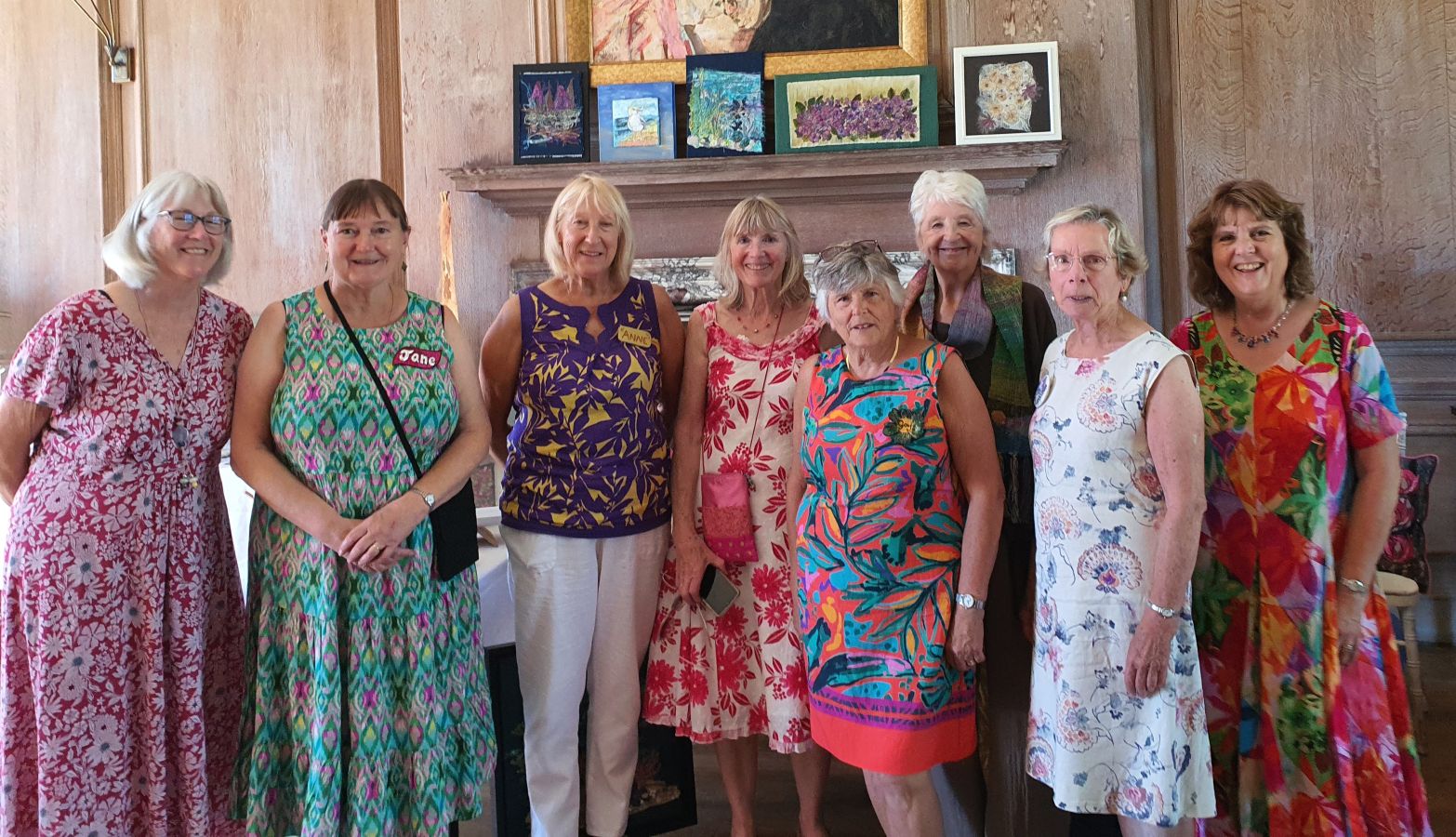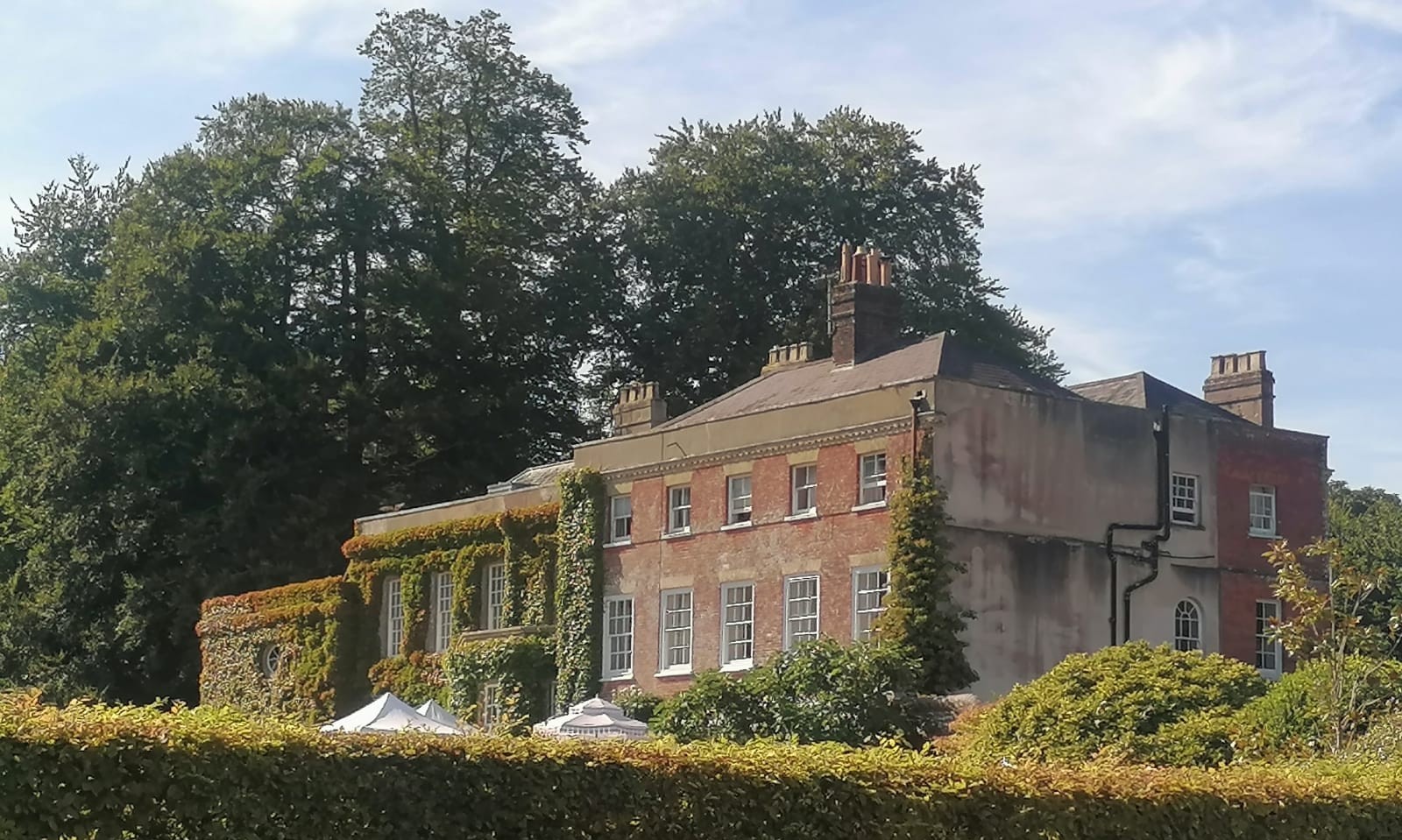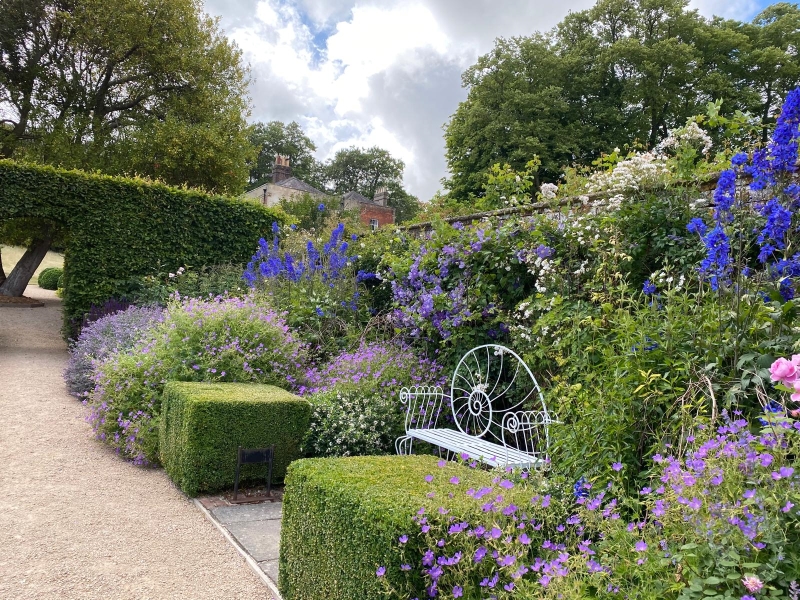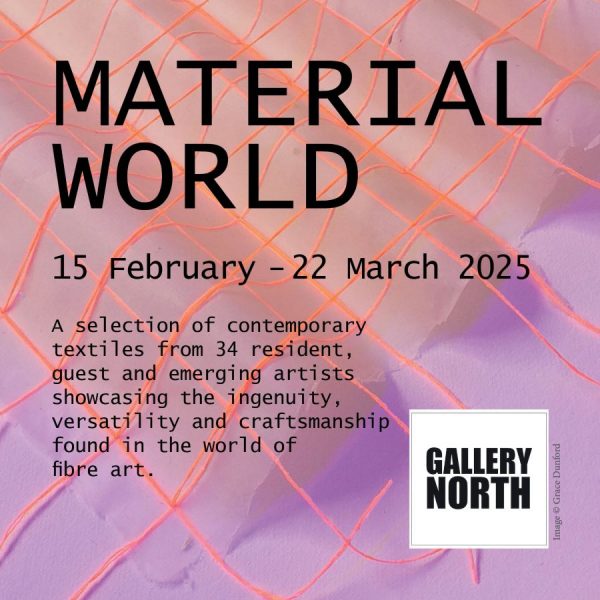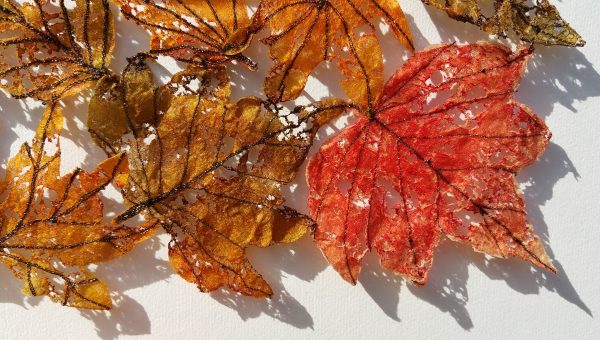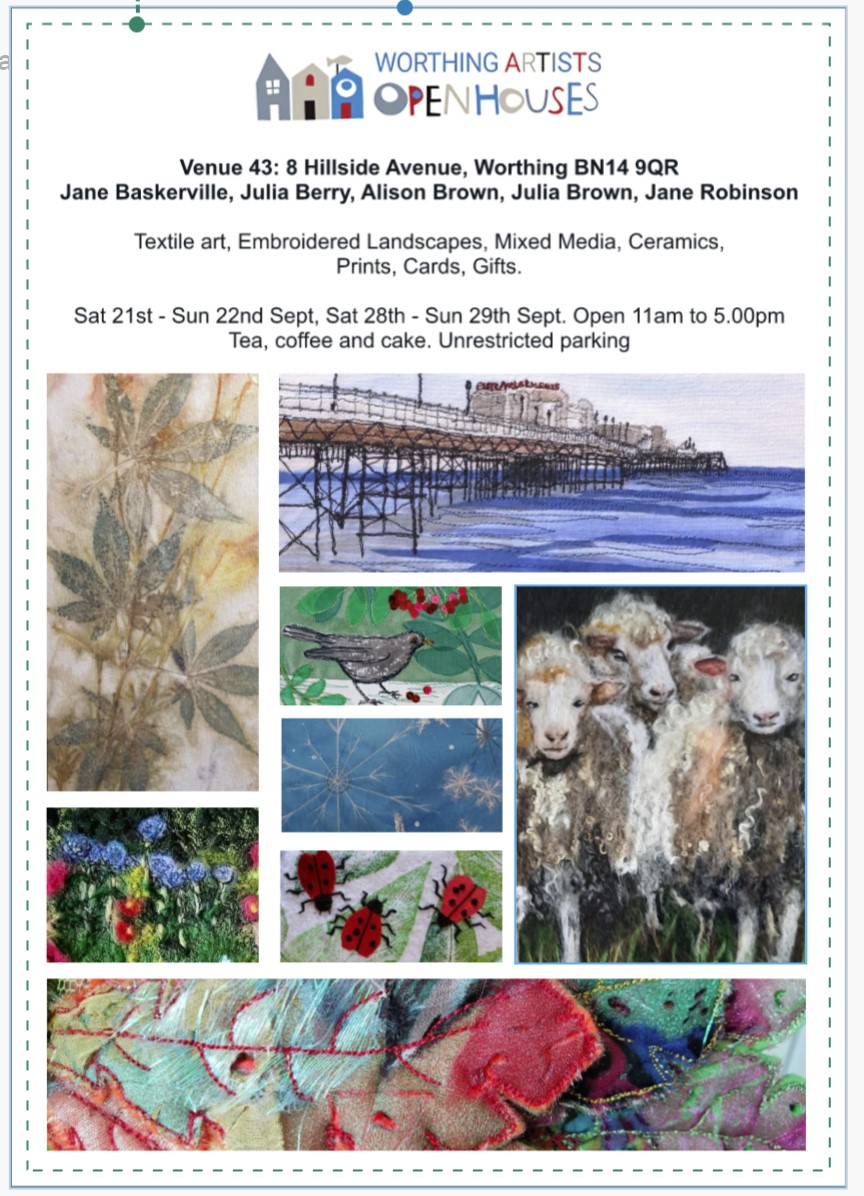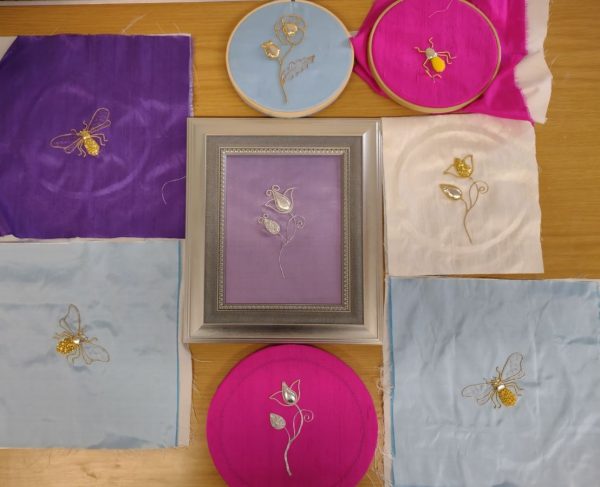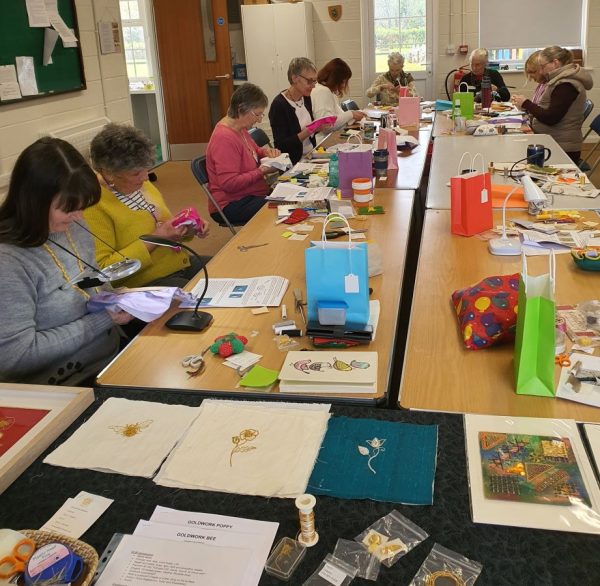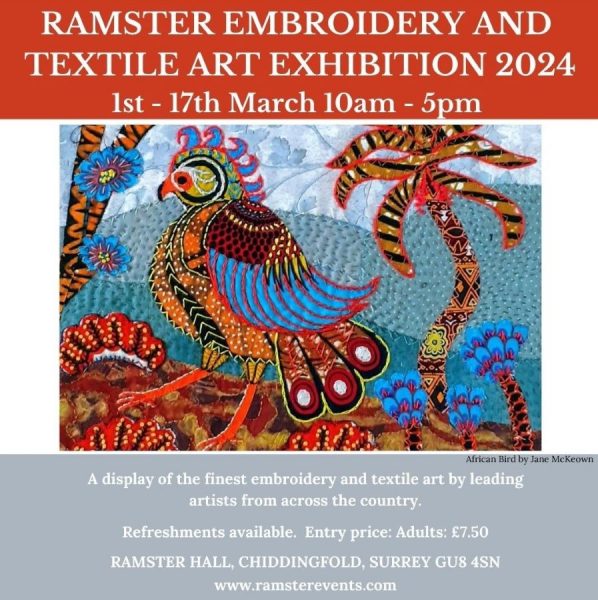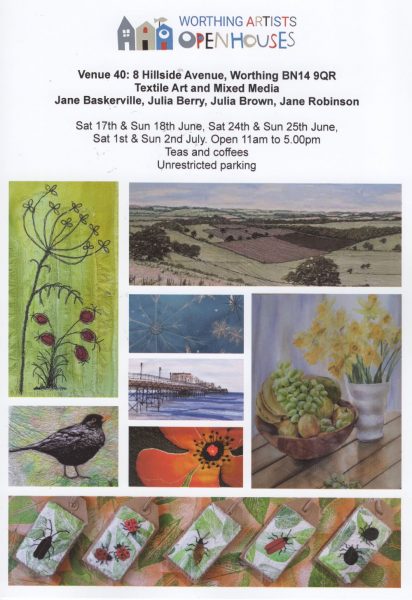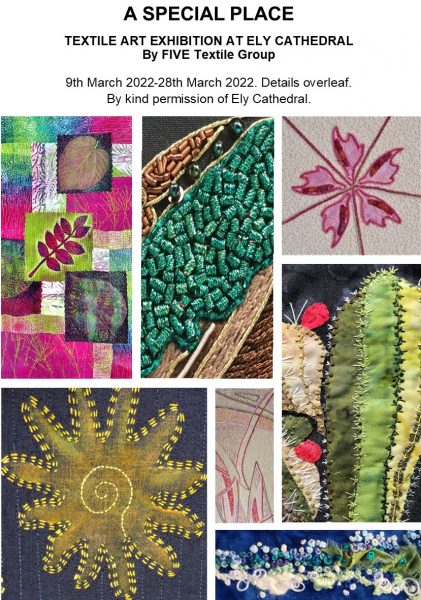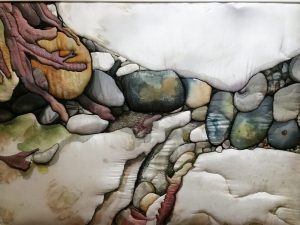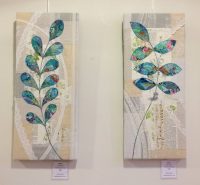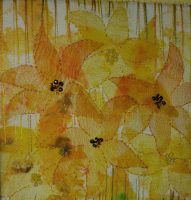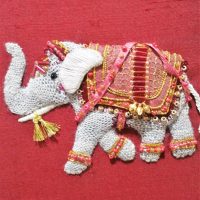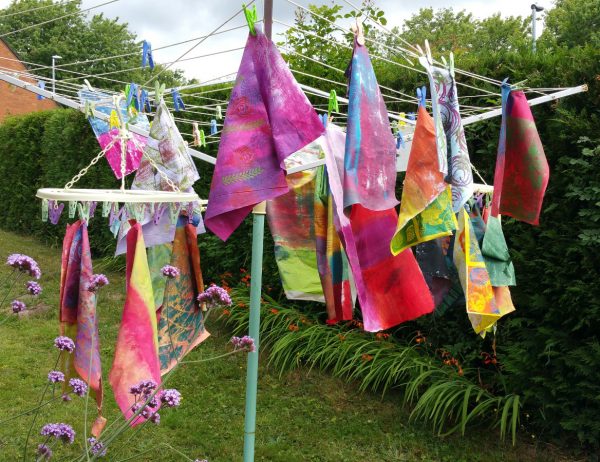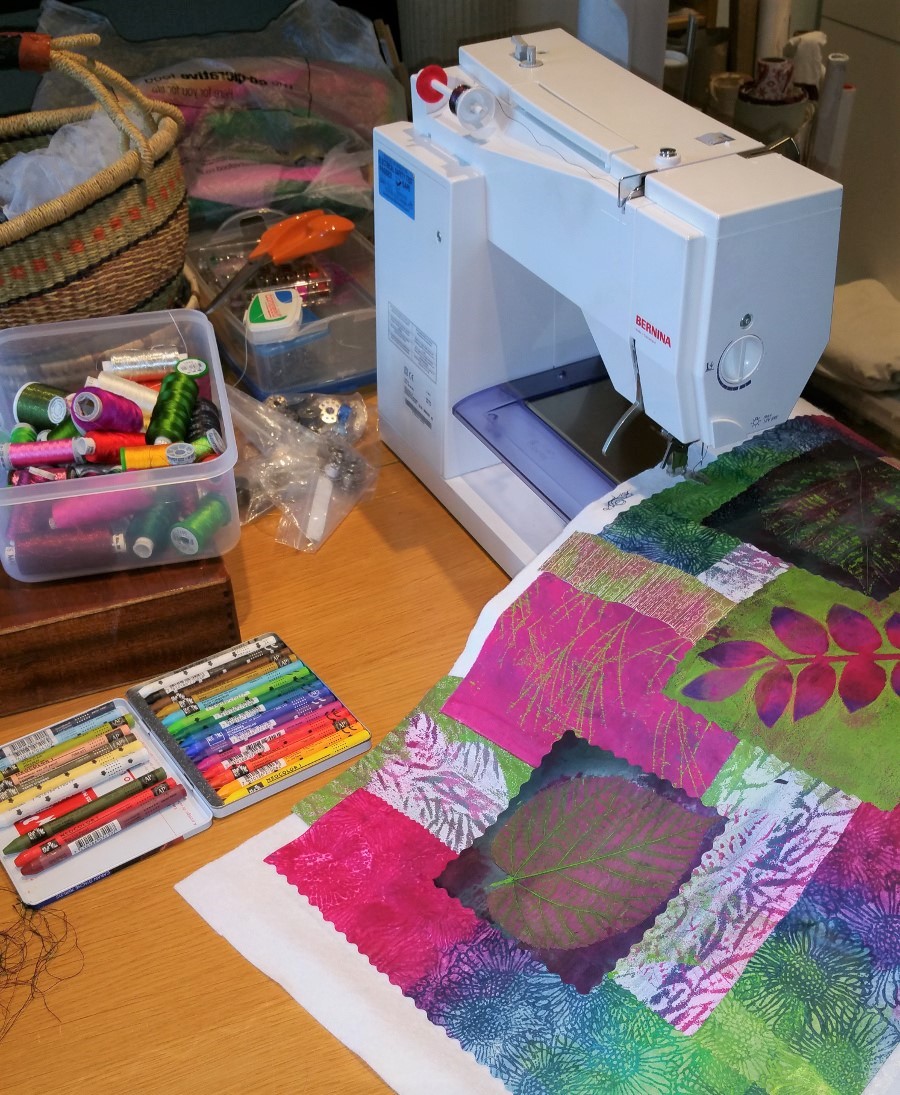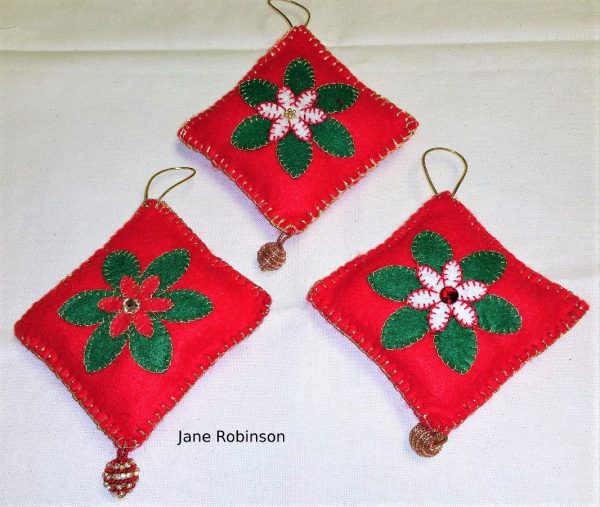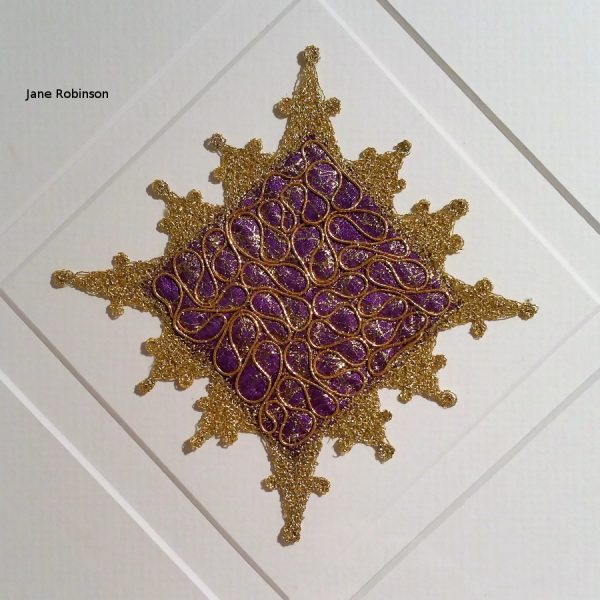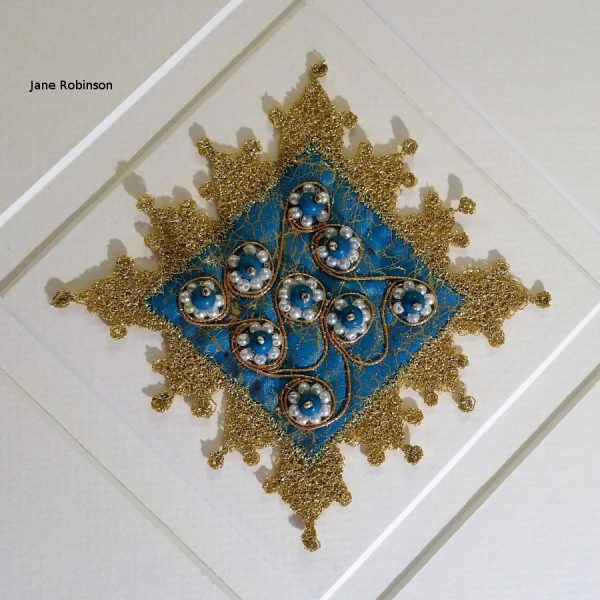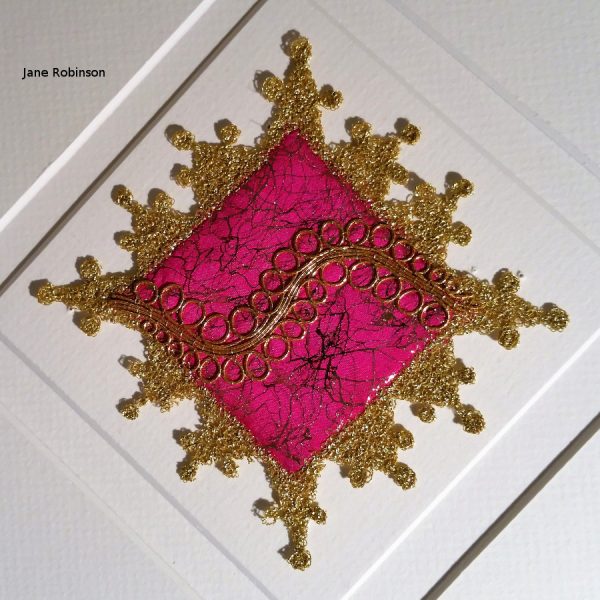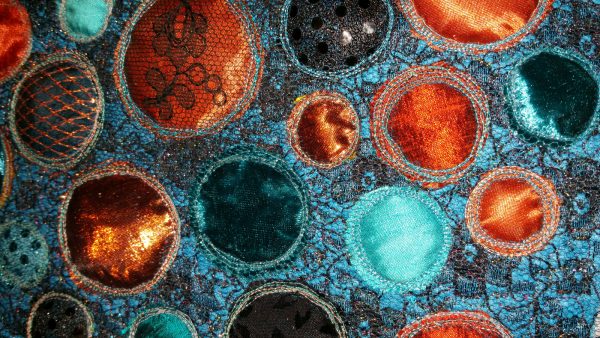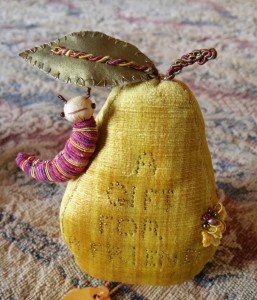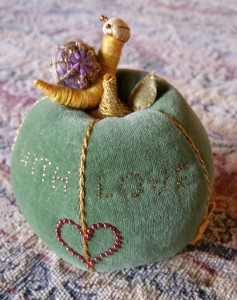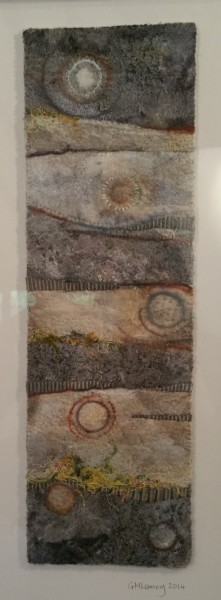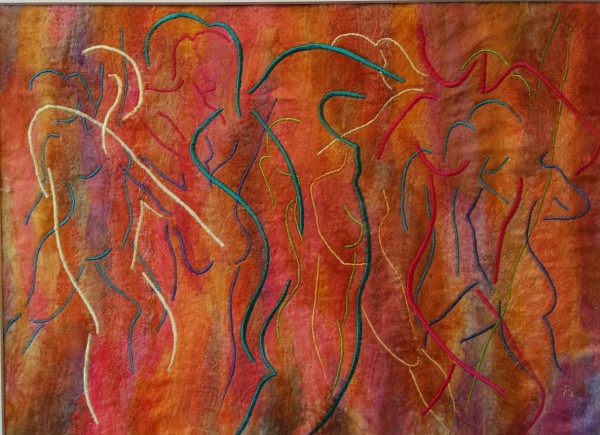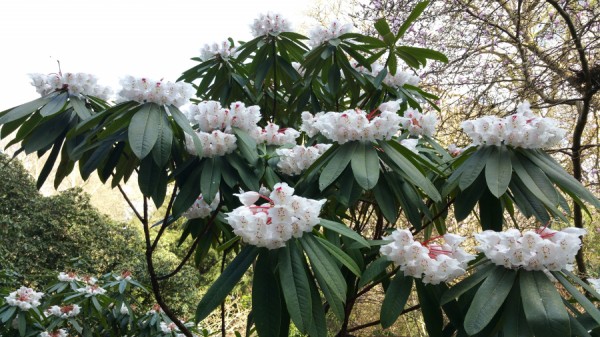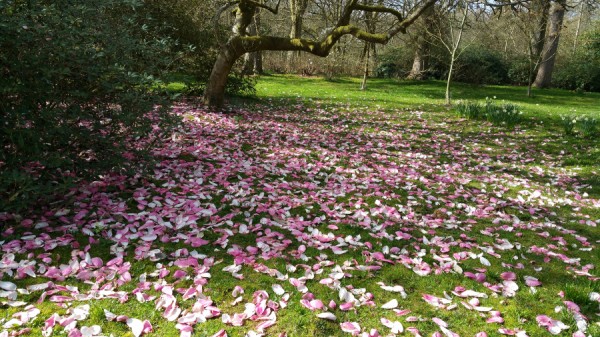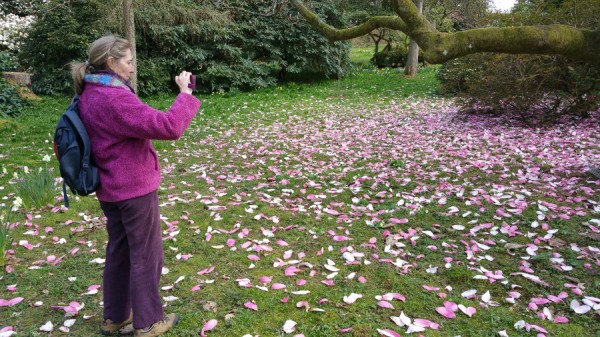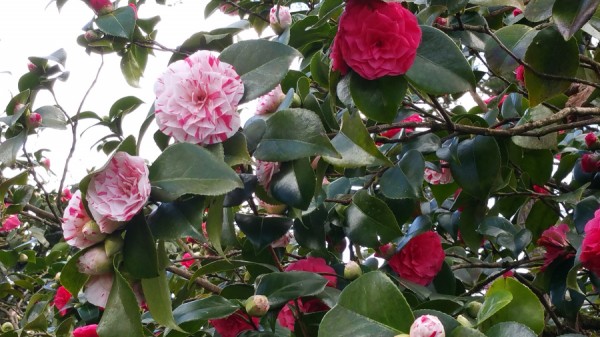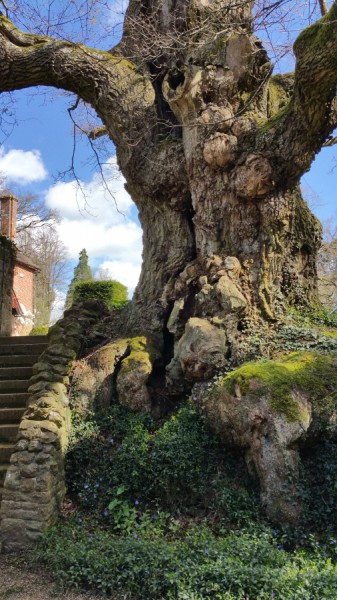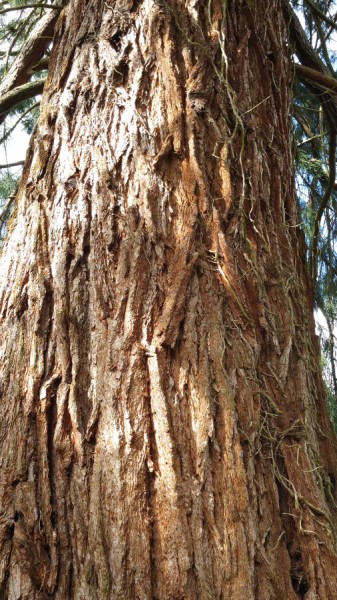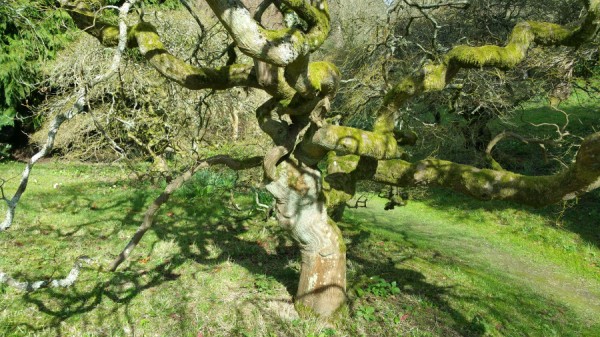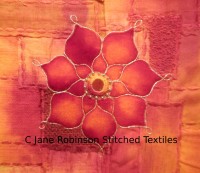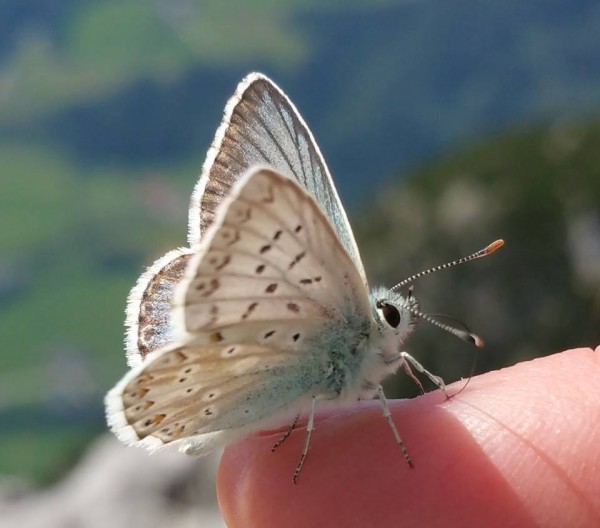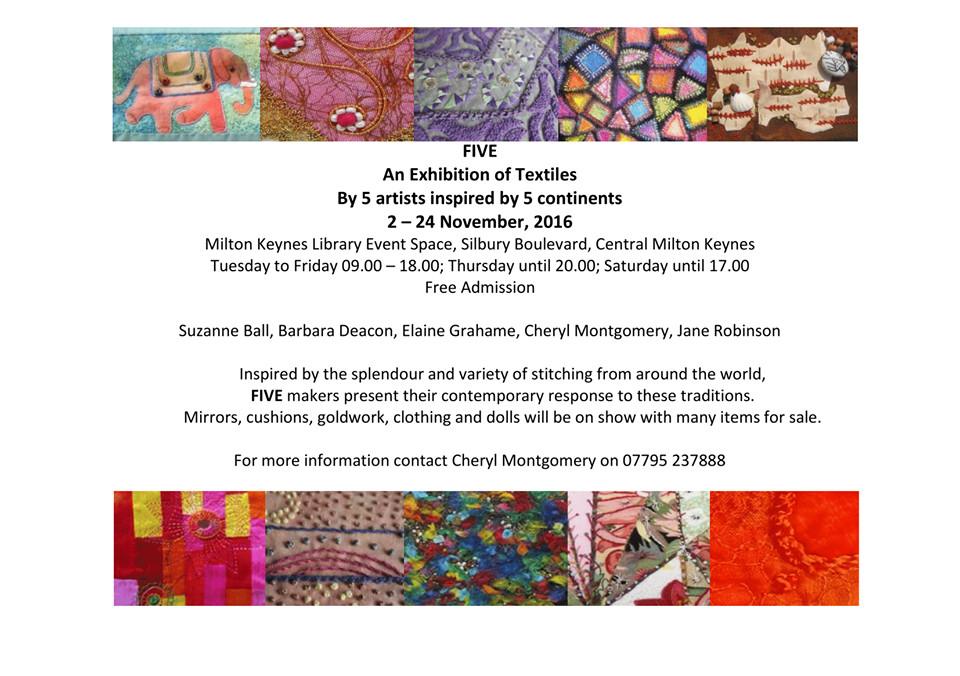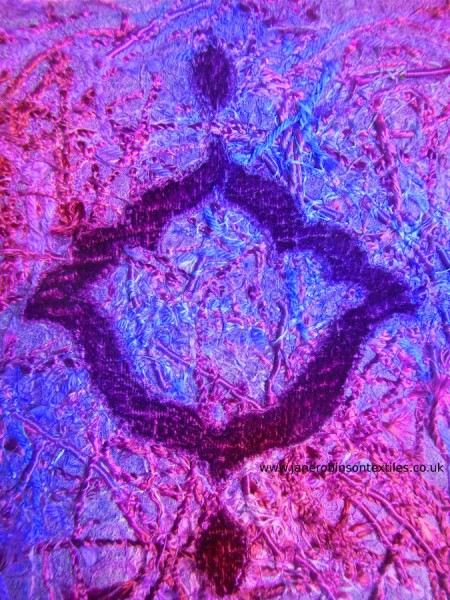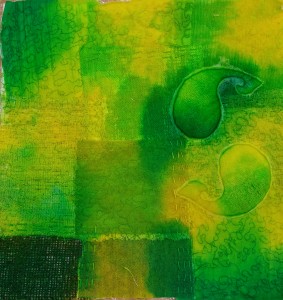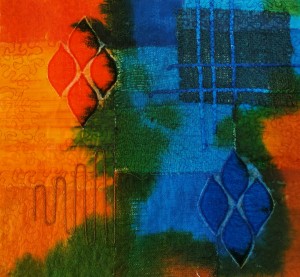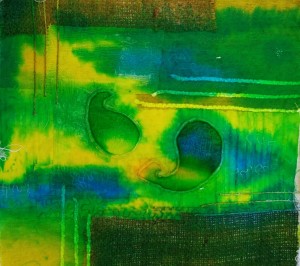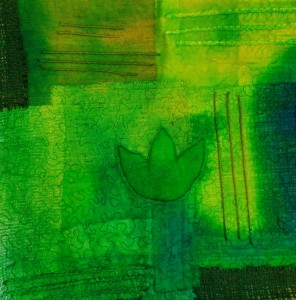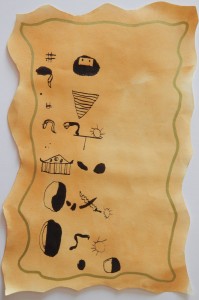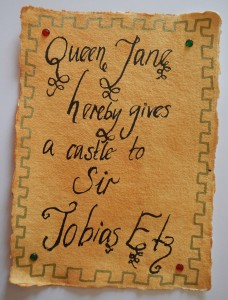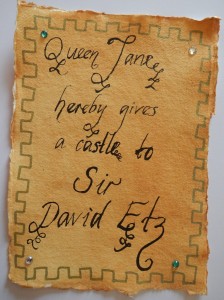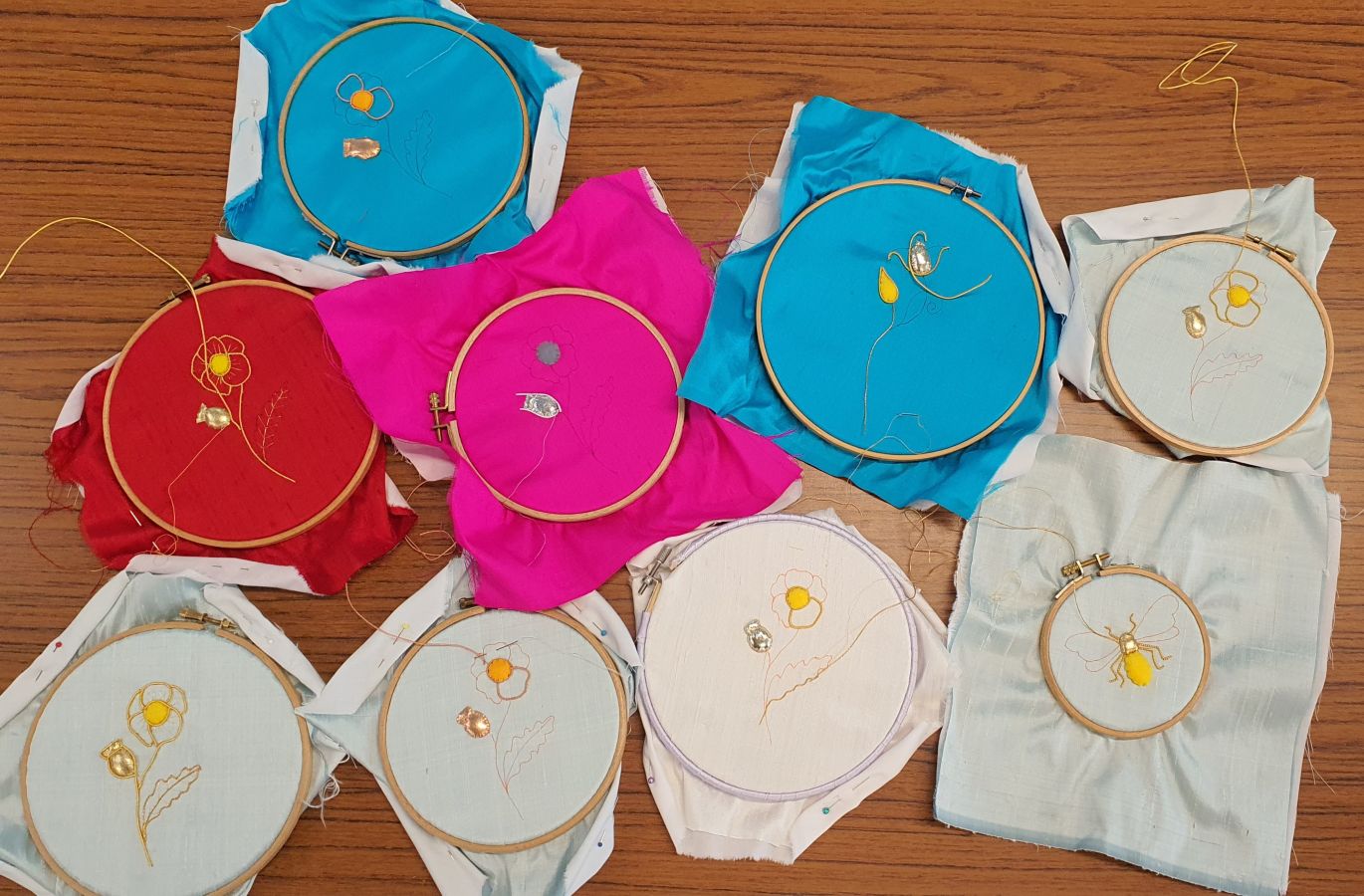 I had a delightful day yesterday, running day on ‘An introduction to goldwork’ for the Brighton Embroidery Group. There were twelve participants, ten of whom were new to goldwork. I’m pleased that they each made a good start on their design. It’s important for everyone to work at their own pace, and hopefully over the day they will have learned what they need to complete their piece at home. It’s great to see another former Embroiderers Guild group thriving since separating from the EG and becoming an independent stitch group.
I had a delightful day yesterday, running day on ‘An introduction to goldwork’ for the Brighton Embroidery Group. There were twelve participants, ten of whom were new to goldwork. I’m pleased that they each made a good start on their design. It’s important for everyone to work at their own pace, and hopefully over the day they will have learned what they need to complete their piece at home. It’s great to see another former Embroiderers Guild group thriving since separating from the EG and becoming an independent stitch group.
The Red Dress
What an amazing afternoon, seeing The Red Dress in person at our monthly meeting of Southdowns Creative Stitchers, and hearing a fascinating talk by Kirstie Mcleod about the world-wide project that created it. More photos here: https://www.southdownscreativestitchers.org.uk/the-red-dress/
Findon Place
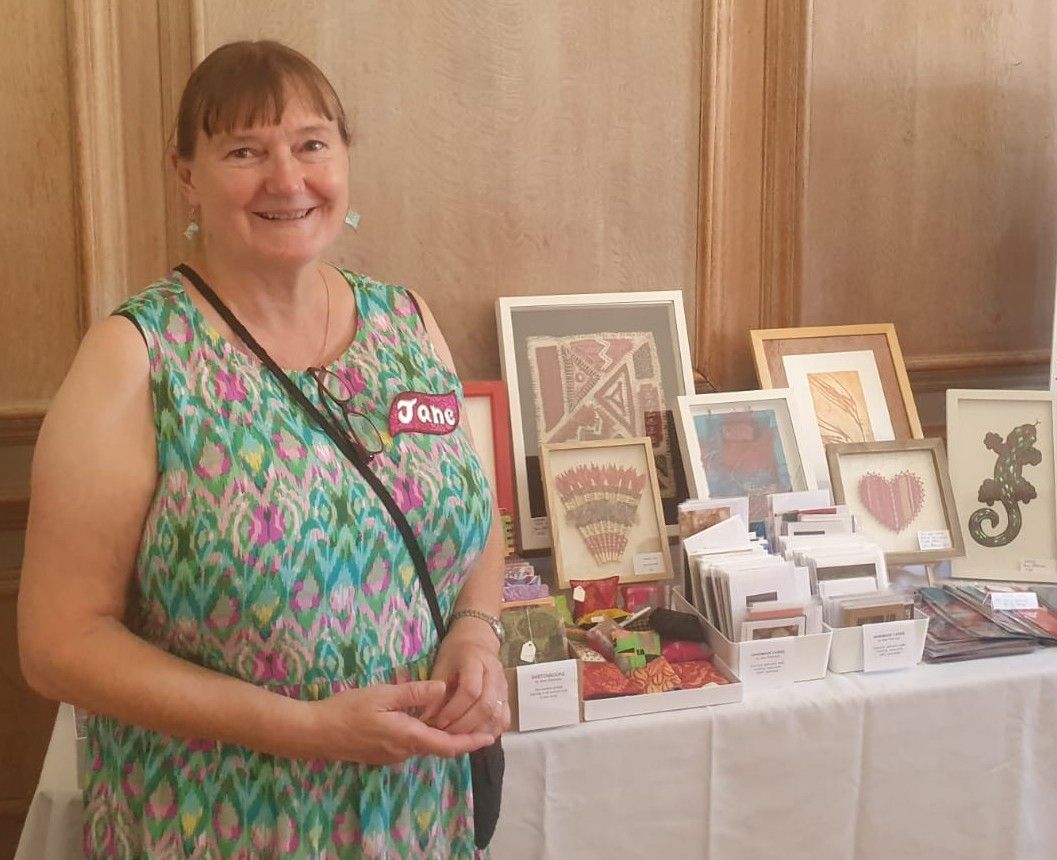 What a lovely day on Sunday, taking part in a pop-up exhibition and sale of art at Findon Place with a group of 8 Sussex artists. We were made welcome at Findon Place, as part of their Open Gardens raising funds for charity on behalf of the National Gardens Scheme. The day was sold out, the sun shone, lots of people were interested in the art, and cream teas were enjoyed. Thank you to Findon Place for inviting us to take part.
What a lovely day on Sunday, taking part in a pop-up exhibition and sale of art at Findon Place with a group of 8 Sussex artists. We were made welcome at Findon Place, as part of their Open Gardens raising funds for charity on behalf of the National Gardens Scheme. The day was sold out, the sun shone, lots of people were interested in the art, and cream teas were enjoyed. Thank you to Findon Place for inviting us to take part.
I’m taking part in a pop-up exhibition at Findon Place this Sunday (17th) during their charity open-afternoon for the National Gardens Scheme. All funds raised through the entry fee to the garden (£7.00) goes to charity. It will be a good day out – there are lovely gardens to see, and cream teas, and the weather forecast is good. If you’d like to come, you need to pre-book via a link on the NGS website – see below. It’s open from 2pm to 5pm. There are directions on the NGS website. It would be good to see you there.
Ecoprint
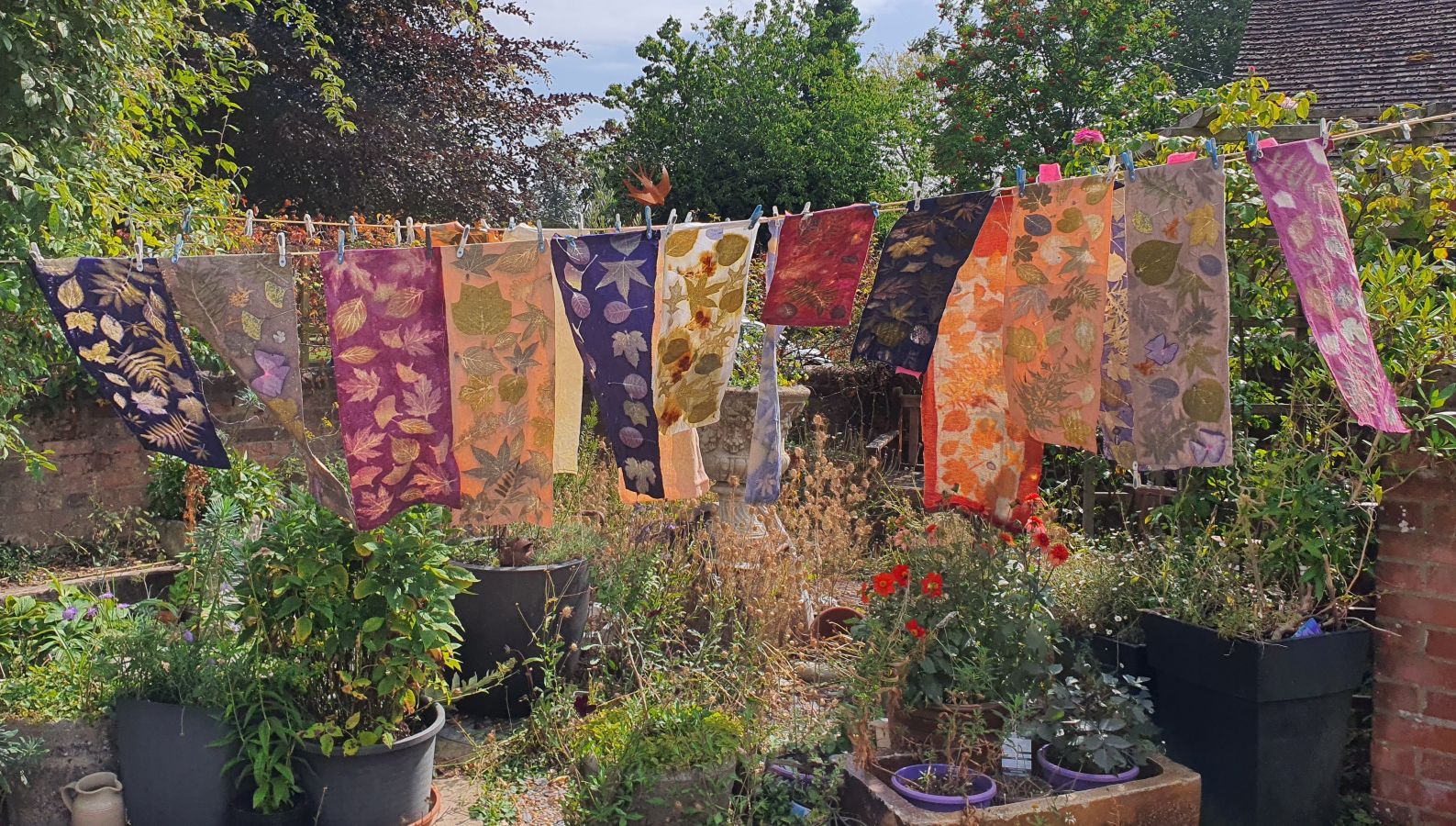 What a fabulous two days at The Granary Studio, with Caroline Bell showing us a very different technique for eco-printing. The use of dyes, alongside the mordants on the fabric, means that a much brighter range of colours can come into it. A nice alternative to the more subtle greys and charcoals that you normally get with eco-printing.
What a fabulous two days at The Granary Studio, with Caroline Bell showing us a very different technique for eco-printing. The use of dyes, alongside the mordants on the fabric, means that a much brighter range of colours can come into it. A nice alternative to the more subtle greys and charcoals that you normally get with eco-printing.
Material World textile exhibition
Worthing Artists Open Houses
We had a great first weekend in Worthing Artists Open Houses, where I am taking part at Venue 43. We had lots of visitors, and some interesting and encouraging conversations about our work. We’re open next weekend too (28th-29th September) at 8 Hillside Avenue, Worthing BN14 9QR. Do come along – we’ve got lots of textile art, mixed media, embroidered landscapes, and lots of cards and gift-sized items for sale. It’s the same crew as last year: Jane, Julia, Jane and Julia (yes really!) There is tea, coffee and cake in aid of Care for Veterans, in Julia’s lovely garden if it’s sunny.
Parham House
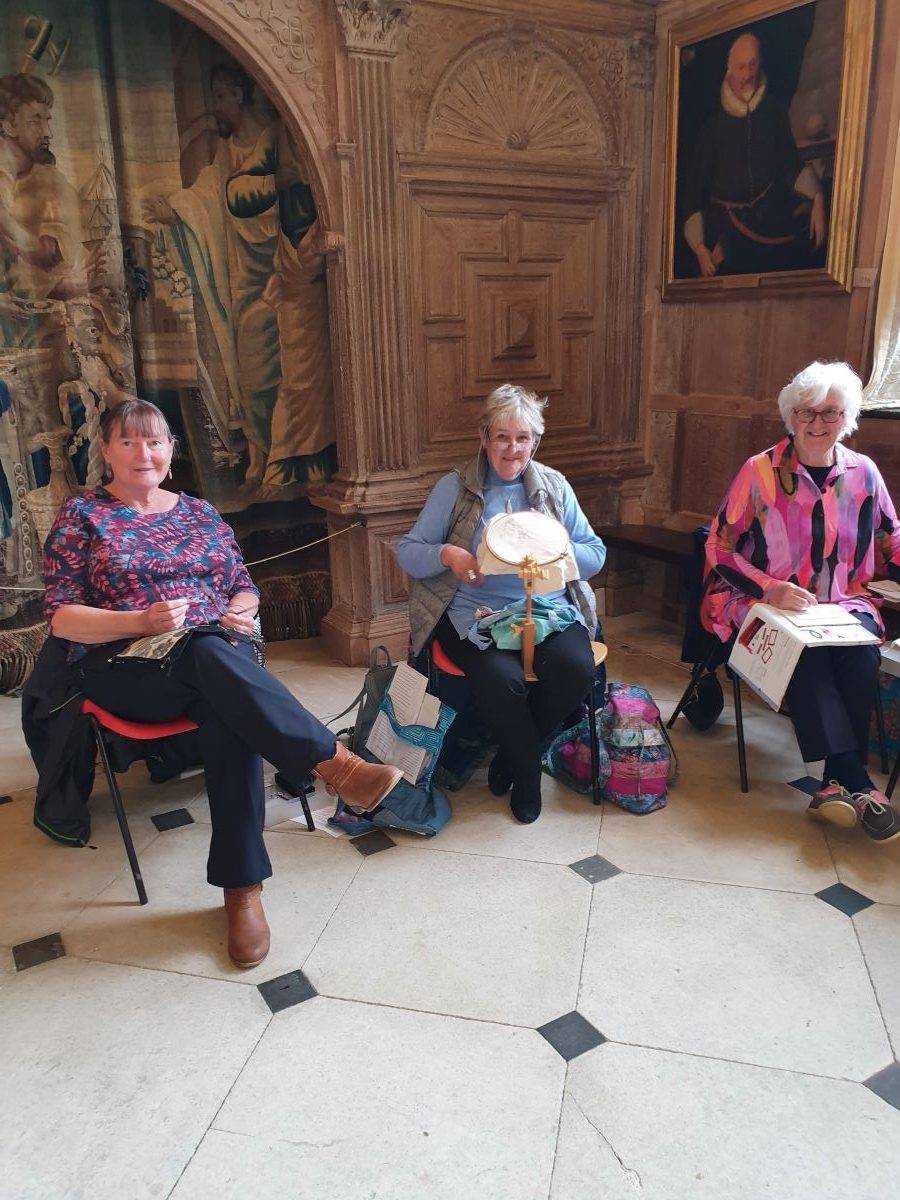 What a pleasure to sit and stitch in the beautiful and peaceful surroundings of Parham House, an Elizabethan manor house in West Sussex. Members of Southdowns Creative Stitchers have a regular arrangement that we send six people once a month to sit and stitch in the house. The house has a well-known collection of historic embroidery, so it attracts a lot of visitors who are interested in embroidery. This makes for a lot of interest in what we’re doing, and some enthusiastic conversations. A delightful way to spend an afternoon.
What a pleasure to sit and stitch in the beautiful and peaceful surroundings of Parham House, an Elizabethan manor house in West Sussex. Members of Southdowns Creative Stitchers have a regular arrangement that we send six people once a month to sit and stitch in the house. The house has a well-known collection of historic embroidery, so it attracts a lot of visitors who are interested in embroidery. This makes for a lot of interest in what we’re doing, and some enthusiastic conversations. A delightful way to spend an afternoon.
Goldwork workshop
I had a lovely day last week, teaching a day-workshop on Goldwork to East Grinstead Embroiderers. It’s so nice to share tips and ideas, and to see people respond. Some had done some goldwork before but others were new to it. It’s a mysterious world of strange terms and specialist techniques, which is highly addictive once you get sucked in. Well done particularly to one member who had never tried anything like it before and seemed very chuffed with her results. Followed a few days later by a talk to Bromley Embroiderers. No photos from that, but what a lovely welcome from the group. It’s so good to see former Embroiderers Guild groups flourishing, and the love of embroidery and textile art being enjoyed and shared.
Ramster
I’m taking part in this exhibition of embroidery and textile art. It’s at Ramster Hall, a lovely 17th century manor house in Surrey. The exhibition will be open from Friday March 1st until Sunday March 17th every day from 10 am until 5pm. There are two big halls of exhibits, with a wide variety of styles and media, including mixed media and all involving at least some stitch. The tea room will be open at the same time. It would be great to see you there; it’s a good day out, and they do great cakes.
Worthing Artists Open Houses
FIVE Textile Art exhibition at Ely Cathedral
Back-strap weaving in the Philippines
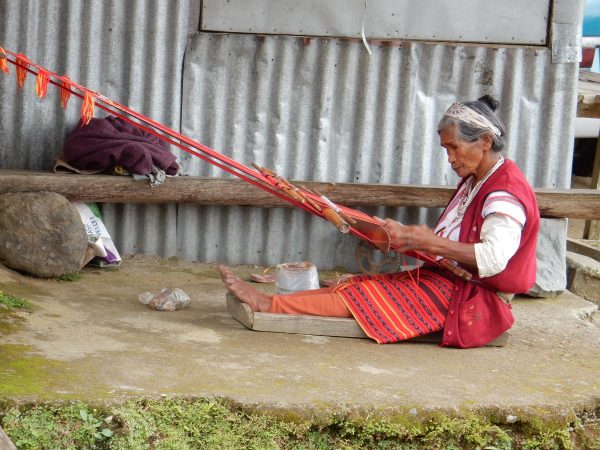 One reason for the gaps in blog posts last year was a rather sudden and unexpected trip to the Philippines. I’ve finally sorted out some of my photos and wanted to share them with you here. Hubby was asked to do some work in the Philippines at quite short notice. Unusually, I was able to clear the decks from work at short notice and go out to join him. This was a surprise trip in many ways. As well as being quite sudden, it was a country that I had no previous knowledge of in terms of culture, politics, art or textiles. Having studied the textiles of my chosen countries in the City and Guilds Diploma course, and having travelled in India and Nepal and various other countries around the world, it was an interesting experience to come across such a very different and unfamiliar culture that I had absolutely no previous exposure to.
One reason for the gaps in blog posts last year was a rather sudden and unexpected trip to the Philippines. I’ve finally sorted out some of my photos and wanted to share them with you here. Hubby was asked to do some work in the Philippines at quite short notice. Unusually, I was able to clear the decks from work at short notice and go out to join him. This was a surprise trip in many ways. As well as being quite sudden, it was a country that I had no previous knowledge of in terms of culture, politics, art or textiles. Having studied the textiles of my chosen countries in the City and Guilds Diploma course, and having travelled in India and Nepal and various other countries around the world, it was an interesting experience to come across such a very different and unfamiliar culture that I had absolutely no previous exposure to.
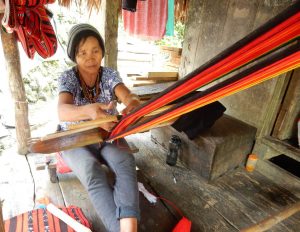
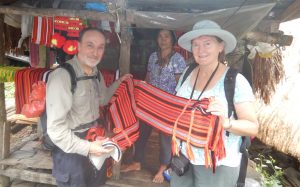 I thought you might be interested to see some of the back-strap weaving that we came across, in the mountainous regions in the north of the country. This lady was weaving in the traditional back-strap method, where the warp is tensioned by a strap round her back. This is the piece that we bought from her. I bought it as a long wall-hanging, and discovered that it is actually a traditional piece that is worn by men as a loincloth in ceremonial dances.
I thought you might be interested to see some of the back-strap weaving that we came across, in the mountainous regions in the north of the country. This lady was weaving in the traditional back-strap method, where the warp is tensioned by a strap round her back. This is the piece that we bought from her. I bought it as a long wall-hanging, and discovered that it is actually a traditional piece that is worn by men as a loincloth in ceremonial dances. 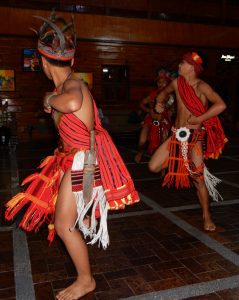 Here are some young lads wearing the loincloths from this village in a ceremonial dance. It was so lovely to see these teenagers enjoying their culture and celebrating it with such gusto, and sharing it with travellers. And at the other end of the age-range, here are some ladies from the village wearing their traditional woven clothing and head-gear.
Here are some young lads wearing the loincloths from this village in a ceremonial dance. It was so lovely to see these teenagers enjoying their culture and celebrating it with such gusto, and sharing it with travellers. And at the other end of the age-range, here are some ladies from the village wearing their traditional woven clothing and head-gear. 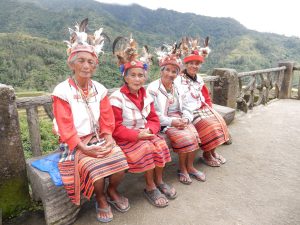
This is the village, surrounded by rice fields and mountains (photos will enlarge of you click on them).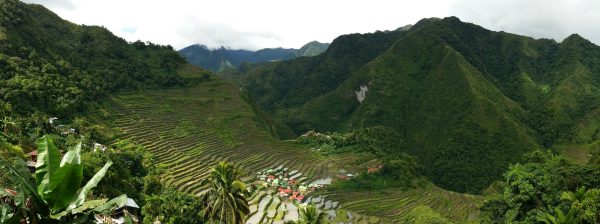
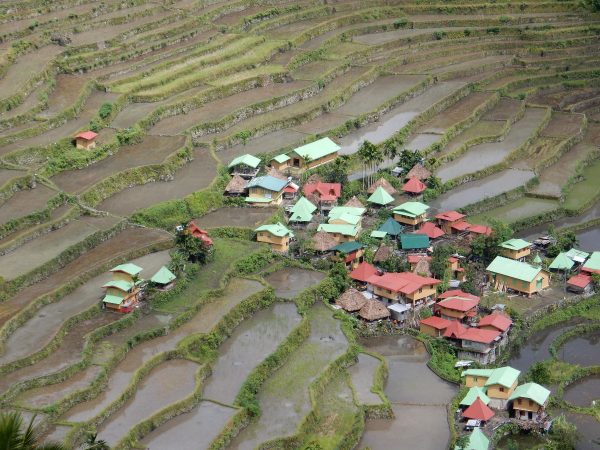 Weaving on the loom – a bigger scale of production, but still hand-made.
Weaving on the loom – a bigger scale of production, but still hand-made.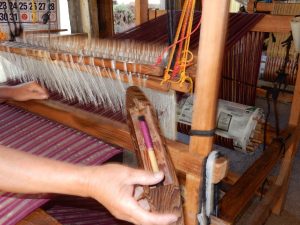
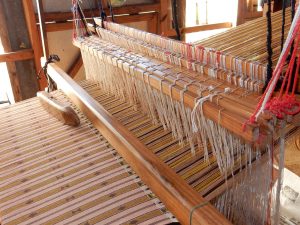 There’s such a rich source of designs and images, everywhere you look.
There’s such a rich source of designs and images, everywhere you look.  What a inspired way to use redundant plastic, to cheer up the front of your house. It makes you think about what we throw away every day.
What a inspired way to use redundant plastic, to cheer up the front of your house. It makes you think about what we throw away every day.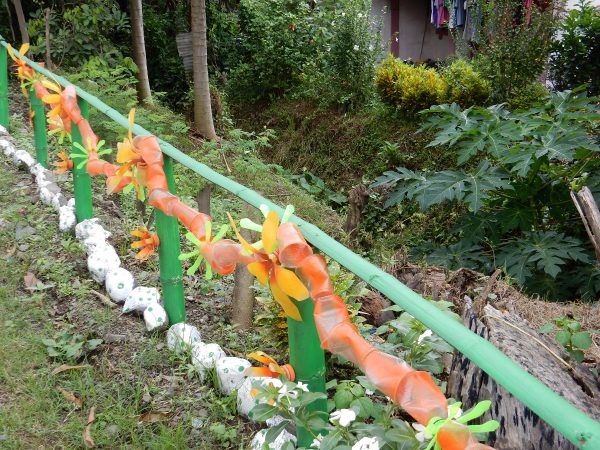 And how about this for a travelling shop? I could go on for ever, but I’ll finish with a photo of me eating an amazing dragon-fruit from a roadside stall. Delicious!
And how about this for a travelling shop? I could go on for ever, but I’ll finish with a photo of me eating an amazing dragon-fruit from a roadside stall. Delicious!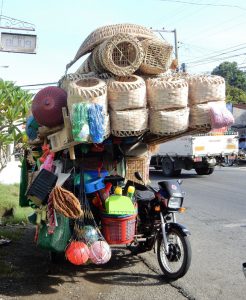
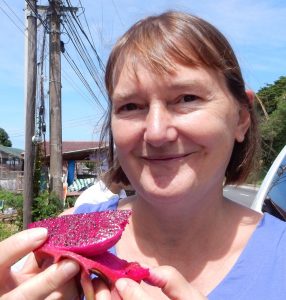
The Thread
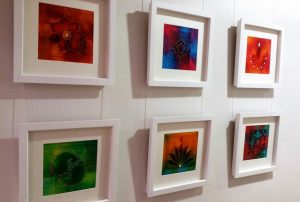 I’m currently taking part in a small textile art exhibition at the Roffey Park Institute near Horsham. Roffey Park has a new exhibition of art-work every 3 months, and this time they
I’m currently taking part in a small textile art exhibition at the Roffey Park Institute near Horsham. Roffey Park has a new exhibition of art-work every 3 months, and this time they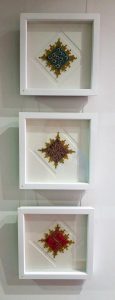 invited six local textile artists. It was good to meet other textile people while we were putting it up (supposedly silently, as
invited six local textile artists. It was good to meet other textile people while we were putting it up (supposedly silently, as 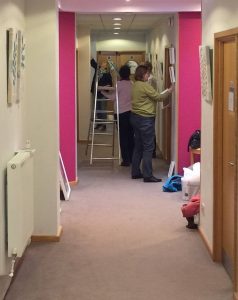 we were installing the art in the corridors while training courses were going on, although silence was hard to achieve once we got chatting). It was lovely to meet the other people exhibiting. If you’d like to visit, please phone the institute first as it’s a working environment.
we were installing the art in the corridors while training courses were going on, although silence was hard to achieve once we got chatting). It was lovely to meet the other people exhibiting. If you’d like to visit, please phone the institute first as it’s a working environment.
Here’s some lovely work by Isobel Moore and Diane Rogers (below). I’ve seen both their work online and in exhibitions, so it was nice to meet them ‘for real’.

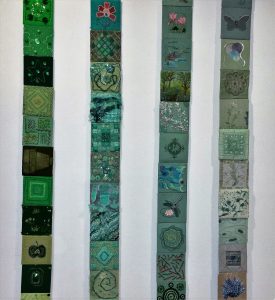 Also on display are the amazing ‘Rainbow hangings’ that were created by different Embroiderers Guild branches. There are 50 or so densely embroidered hangings, made up individually stitched squares of one colour, between them making a lovely rainbow-coloured collection. They were stitched by different Embroiderers Guild branches and put together as a collective exhibition that tours the country. Here are 2 close-up examples.
Also on display are the amazing ‘Rainbow hangings’ that were created by different Embroiderers Guild branches. There are 50 or so densely embroidered hangings, made up individually stitched squares of one colour, between them making a lovely rainbow-coloured collection. They were stitched by different Embroiderers Guild branches and put together as a collective exhibition that tours the country. Here are 2 close-up examples.
Last year…
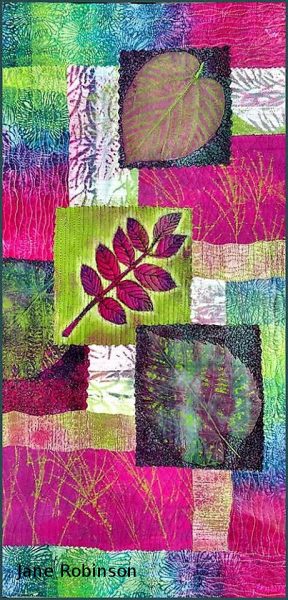 So many blog posts get partly written in my head, usually when I’m driving, when I have time to think about it but not actually do it……and then a month goes by, and another month…….
So many blog posts get partly written in my head, usually when I’m driving, when I have time to think about it but not actually do it……and then a month goes by, and another month…….
There’s always something else pressing, like ‘life and stuff’. I’ve been sucked into Facebook (a bit late to the party, resisting all the way, but now I’ve become quite an addict). And I think there’s also a loss of momentum with blogging, and wondering who is out there reading it. FB is so quick and immediate; just toss in a photo and a couple of sentences, and job’s a good’un. There’s an argument in my head between the appeal of the instant click and share, and the enjoyment of longer reflections and ramblings with time to explore thoughts and ideas. But if I always aim for longer reflections then this may be part of the reason why I don’t get round to doing it, so maybe I need to start again with shorter simpler posts. Anyway, to get started again I thought I’d just post some a few random photos of what I’ve been up to since my last post.
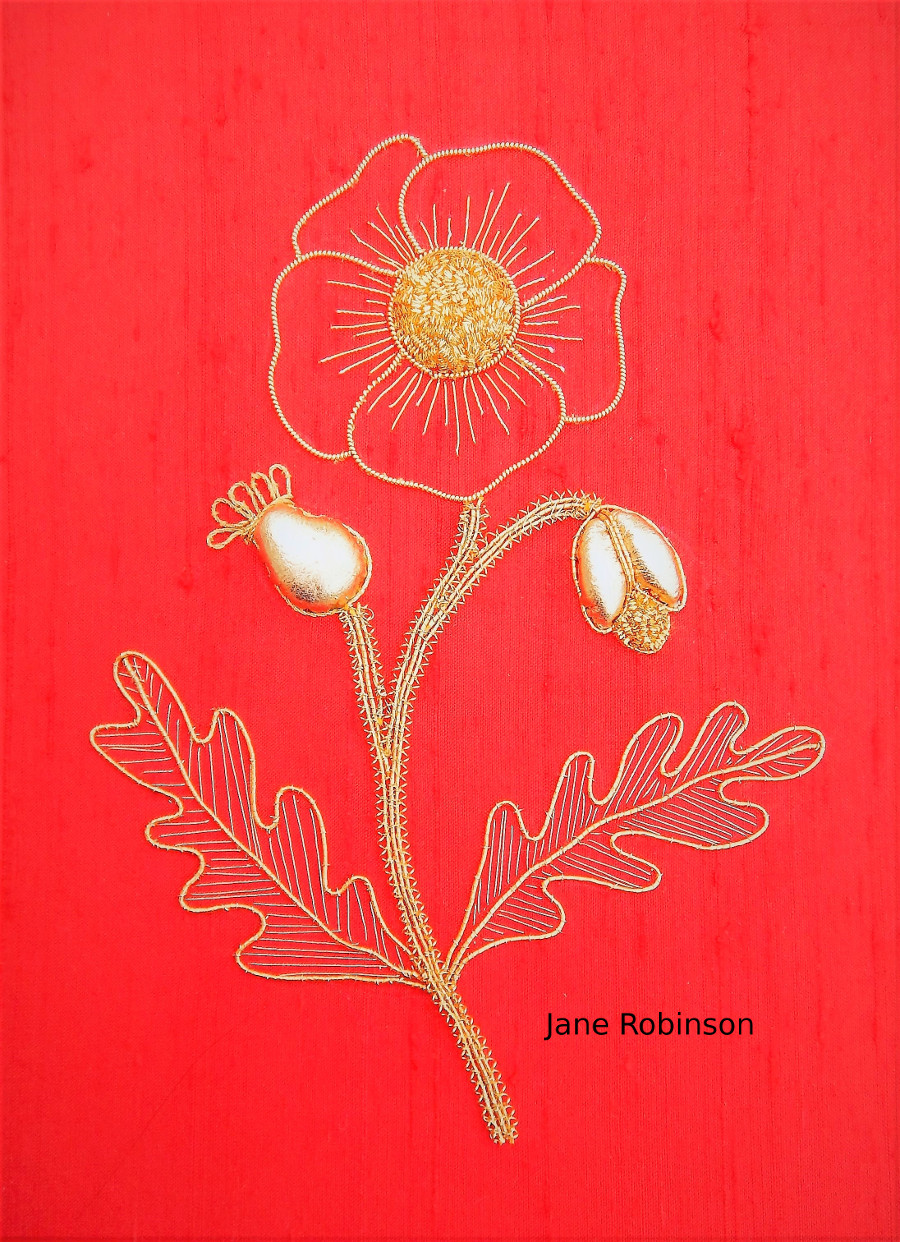
Goldwork poppy, my entry for the Embroiderers Guild ‘Page 17’ Exhibition. Each entry is inspired by Page 17 of a chosen book – in my case W Keble-Martin’s ‘The Concise British Flora in Colour’
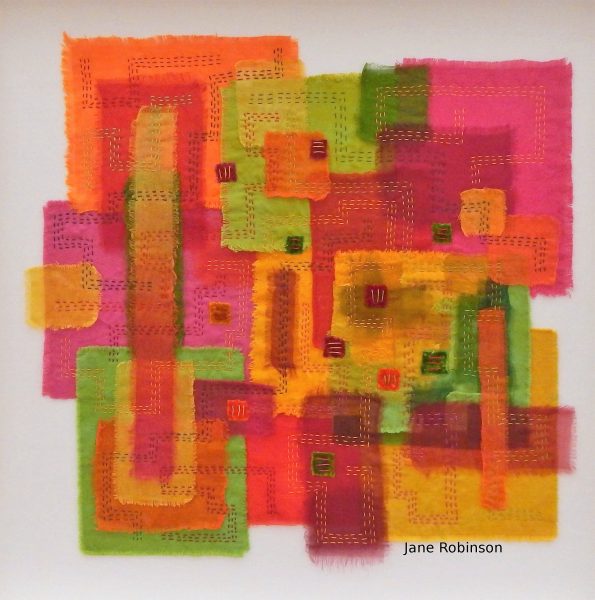
This is going back a bit now, but I think I posted it as work in progress but never put the finished thing on here.
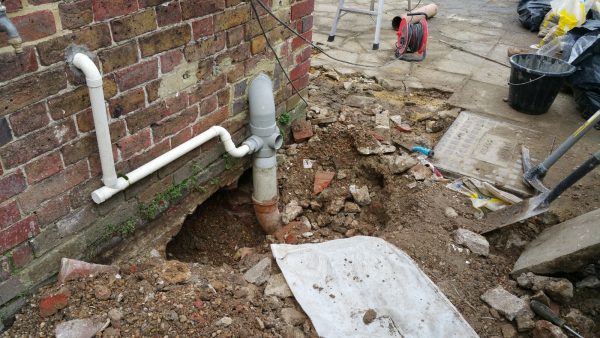
Unexpected holes under the house are very distracting. We are surrounded by a sea of mud, while the path and terrace are being drilled/dug up. It’s amazing how much time and energy these things absorb.
Oh, and another distraction is that I’ve been working on a new website for Worthing Tuesday Embroiderers Guild. It’s had more attention than my own website, so do check it out here.
That’s all for now. It would be great to know who reads this. I know from Google Analytics that people do visit, but I’d love to know who you are so do leave a comment. ‘Toodle Pip’.
Ramster Embroidery Exhibition 2017
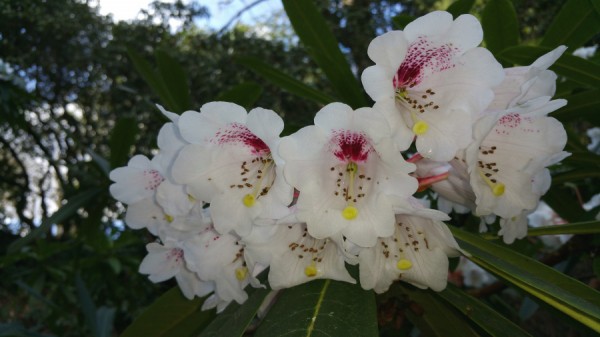 It has been great to take part in the Ramster Embroidery Exhibition 2017. Exhibiting alongside some well-known names is slightly daunting, but it’s been an enjoyable and friendly experience. It was wonderful to see so much textile art all together in one place – I think there were nearly 300 exhibits, by 120 different artists, and all so varied. I’ve picked out a few pieces here that I particularly liked.
It has been great to take part in the Ramster Embroidery Exhibition 2017. Exhibiting alongside some well-known names is slightly daunting, but it’s been an enjoyable and friendly experience. It was wonderful to see so much textile art all together in one place – I think there were nearly 300 exhibits, by 120 different artists, and all so varied. I’ve picked out a few pieces here that I particularly liked.
I love the pincushions above by Jane Cobbett. They are inspired by a Victorian pincushion although they remind me of the mad little silk-worms that are often featured in Elizabethan embroidery. I like the insane grin on the stripy one’s face. I also like the way the velvet pear looks kind of aged.
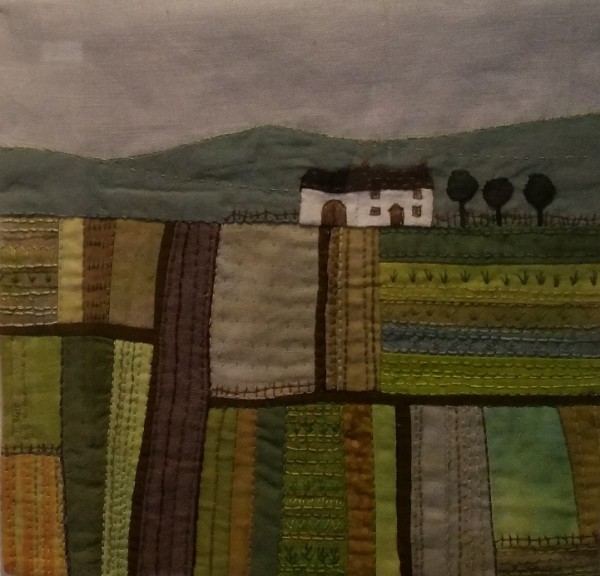 One of my favourites is ‘House in the Fields’ by Jane Mckeown. There’s something quite modest about it that appeals to me. Even though I have no idea where it is (maybe it’s not a real place at all), but my instant thought was ‘I know that place’. Maybe it reminds me of the small-holding in the Shropshire hills that my parents ran until I was three. It’s beautifully coloured and proportioned. I think it adds so much that the sky is grey not blue, and I love the rows of vegetables all carefully tended. I think it’s a lovely under-stated piece. See more of Jane’s lovely work here
One of my favourites is ‘House in the Fields’ by Jane Mckeown. There’s something quite modest about it that appeals to me. Even though I have no idea where it is (maybe it’s not a real place at all), but my instant thought was ‘I know that place’. Maybe it reminds me of the small-holding in the Shropshire hills that my parents ran until I was three. It’s beautifully coloured and proportioned. I think it adds so much that the sky is grey not blue, and I love the rows of vegetables all carefully tended. I think it’s a lovely under-stated piece. See more of Jane’s lovely work here
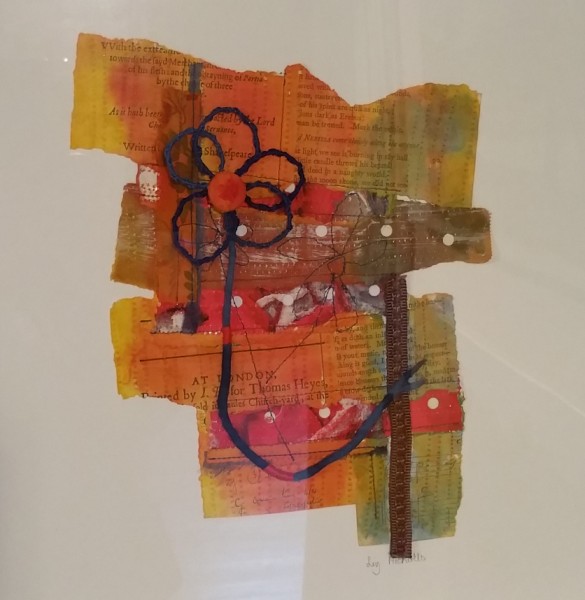 Above: Elizabeth Nicholls, Burning Embers. I like the colours and the freedom of this piece.
Above: Elizabeth Nicholls, Burning Embers. I like the colours and the freedom of this piece.
Above: Gillian Lamey, Seed Heads 2. This appeals to me because of it’s subtlety. The textures are wonderful (they don’t show up too well here due to the reflective glass, but in real life they’re lovely).
Rita Johnson, Inside the Dance, Embellishment and machine embroidery. I like the sense of movement in this, and the colours.
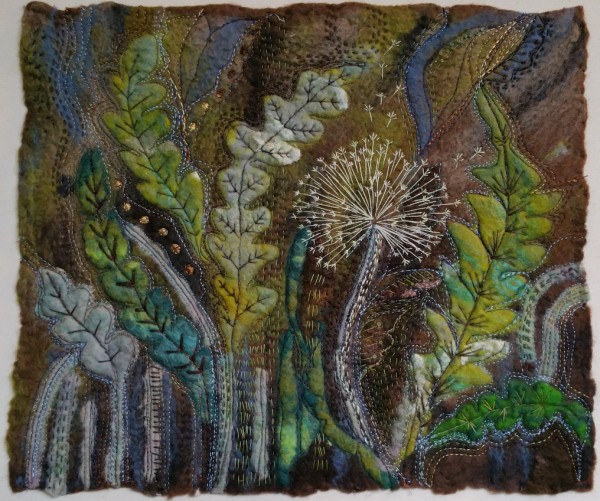 Above: Jacky Cardy. I treated myself to one of her lovely felted and embroidered bird brooches – I just couldn’t resist.
Above: Jacky Cardy. I treated myself to one of her lovely felted and embroidered bird brooches – I just couldn’t resist.
We took the opportunity for a walk round the beautiful Ramster gardens. The enormous flowering shrubs and trees are magnificent. Some of the magnolias have held their leaves and others had shed them into bright pink carpets (spot the colour coordination with my friend’s clothes!) Does anyone know what this amazing flowering tree is?
Unaccustomed as I am…
 I’ve given two talks in the space of a week. The first was to the Milton Keynes Embroiderers Guild which coincided with our new textile art exhibition there by ‘FIVE’ (here’s a photo of part of the exhibition – more about that in a later post). The second talk was to Wey Valley Workshop Textile Group in Godalming. I’m delighted to report that I actually enjoyed both of them! No need to lie down in a darkened room to recover, although that bottle of wine later on in the evening did hit the spot. Both groups were lovely and welcoming, and everyone was really friendly. I was pleased with the response to both talks, and I’ve been pondering over why I was apprehensive about it beforehand.
I’ve given two talks in the space of a week. The first was to the Milton Keynes Embroiderers Guild which coincided with our new textile art exhibition there by ‘FIVE’ (here’s a photo of part of the exhibition – more about that in a later post). The second talk was to Wey Valley Workshop Textile Group in Godalming. I’m delighted to report that I actually enjoyed both of them! No need to lie down in a darkened room to recover, although that bottle of wine later on in the evening did hit the spot. Both groups were lovely and welcoming, and everyone was really friendly. I was pleased with the response to both talks, and I’ve been pondering over why I was apprehensive about it beforehand.
Surveys asking what people worry about seem to suggest that fear of death only occupies the number two spot. Fear of public speaking comes in at number one. It’s that 3am kind of worry, when the house is silent, the dressing-gown hanging on the back of the door in the darkness is someone lurking silently in the shadows, and the people you are going to speak to the next day are definitely going to eat you.
I’ve done my share of giving evidence in Court for work, so I’m used to preparing myself for cross-examination by a hostile barrister whose purpose in life is to make you look stupid, or contradict yourself, or lose your thread, or burble. You do gradually learn the tricks that the barristers employ such as ‘The Withering Look’ or the facial expression that says ‘I Cannot Believe You’ve Just Said Something Quite So Stupid’. I have to remind myself that when I’m speaking to a textile group I am actually talking to a friendly group of like-minded people who have come along because they share the same interest in textiles, and who have come along in a positive spirit. Old habits die hard though, and it is lovely when I have got started and begin to realise that I’m not going to be eaten for breakfast. I start to see nods and smiles and no Withering Looks. The icing on the cake is that the questions are friendly and interested, not critical.
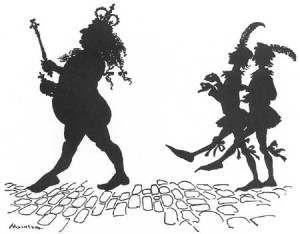 I think part of the apprehension is also an element of ‘So what do I know’. I get invited to do these talks on the strength of having won the C&G Gold Medal for Excellence in Stitched Textiles, rather than because of the years of exhibiting, teaching and publishing experience that many speakers have. I find myself thinking ‘If I had more years experience in textile art, then I would have more to say’. Let me confess something. Once, the night before giving evidence in Court, I dreamt that I was standing in the witness box dressed up in my formal Court clothes except that I had forgotten to put on my skirt. ‘Beam me up, Scotty!’ So, what actually is the worry? Being exposed, like the emperor in his non-existent new clothes? Being caught out? Being found lacking in some way? All of the above, I suspect. So it’s really exciting and liberating to have a positive response to my talks from these two lovely groups (and I’m pleased to say that I did remember to get dressed beforehand!)
I think part of the apprehension is also an element of ‘So what do I know’. I get invited to do these talks on the strength of having won the C&G Gold Medal for Excellence in Stitched Textiles, rather than because of the years of exhibiting, teaching and publishing experience that many speakers have. I find myself thinking ‘If I had more years experience in textile art, then I would have more to say’. Let me confess something. Once, the night before giving evidence in Court, I dreamt that I was standing in the witness box dressed up in my formal Court clothes except that I had forgotten to put on my skirt. ‘Beam me up, Scotty!’ So, what actually is the worry? Being exposed, like the emperor in his non-existent new clothes? Being caught out? Being found lacking in some way? All of the above, I suspect. So it’s really exciting and liberating to have a positive response to my talks from these two lovely groups (and I’m pleased to say that I did remember to get dressed beforehand!)
I based these talks on exploring questions about why adults so easily lose the creativity that they had when they were children, and how we can get it back if we do lose it. This is something I’ve thought about a lot, because it connects with both my professional working life and my re-discovery of creativity and textiles later on in life.
When I did two previous textiles talks last year I found it very distracting using written notes. It was like someone switching on a fan that blew all my ideas around into heaps of chaos. Those two talks definitely had some Grade A burbling! ‘The mind is a wonderful thing. It starts working the moment you are born and never stops until you stand up to speak in public’. (Roscoe Drummone). So this time I decided to use the digital images as the prompts instead, and to have no written notes at all. This worked much better, I think. It did occur to me that it would be good to have a Plan B in case of technical failure, but hey, they say adrenaline sharpens the mind.
I guess it will take some time until I lose the unnerving feeling that when I speak about textiles, people are secretly wondering why I forgot to get dressed! I’m not quite sure where the transition comes between being an enthusiastic amateur and being a professional artist. I have a kind of reverence for ‘proper’ textile artists – the ones who earn their entire living through their art. I’m coming into this quite late compared to the bright young things who emerge from art college, so I think I’ll just carry on bumbling along and developing my work and I’ll see where it takes me. In the meantime, with these latest two talks I feel I have dipped my toe into the water. I’m so pleased to find that the water was warm and there weren’t any crocodiles lurking below the surface.
Dona Nobis Pacem: Grant Us Peace
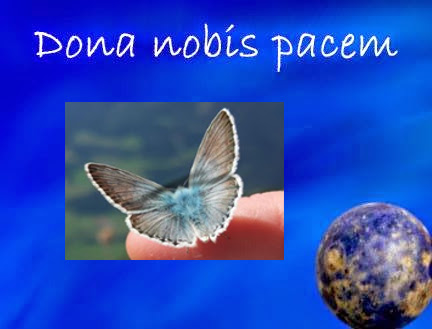 Today, 4th November, over 70,000 people are writing about peace on their blogs. This is organised by ‘Blog4Peace’ which was started by Mimi Lenox 10 years ago. Now over 70,000 bloggers join her on this day each year, to record their messages of hope and peace.
Today, 4th November, over 70,000 people are writing about peace on their blogs. This is organised by ‘Blog4Peace’ which was started by Mimi Lenox 10 years ago. Now over 70,000 bloggers join her on this day each year, to record their messages of hope and peace.
I heard about this from a blog I follow, Dancing With Sunflowers. Janice Heppenstall has written about the darkness and despair of current times, the wish to make it better, and the importance of small acts of peace. I think if I tried to add my own version of what Janice has written then I’d only be paraphrasing her words, so with her permission I’ve put a link here so you can read her words yourself.
Sometimes I just feel helpless in the face of the cruelty and bleakness in the world. Some days I avoid watching the news because it feels like there’s nothing I can do except feel rage and despair, which doesn’t change anything or help anyone.
I find peace and hope in the people I love, in nature, and in the vibrant colours of art and textiles. But I do sometimes feel guilty about enjoying such things when other people don’t have the basics of clean water, safety, shelter or food. I feel a sense of responsibility to know what is happening in the world, as if I should be ready to spring into action ‘when the time comes’. I read about the courage of people who put their freedom or even their lives at risk in order to fight for what they believe in. In their shoes, I wonder if I would have the courage to stand my ground, with sword or pen (or computer mouse) in hand? Or would I actually be cowering behind safety, wishing I was braver? I guess none of us know which way we would leap at the crucial moment.
Recently when I was worrying about what I could actually do to help, I read a call-out for volunteers to load a lorry going out to Iraq loaded with donated medical supplies. It was in a warehouse two streets away from me, on a day when I wasn’t working, and so it was easy to walk round and spend the morning lifting and carrying. It was a small gesture – one morning of my life – but what else can you do except small things?
There are places in the world where writing about peace, or even writing a blog about anything at all, would mean risking your life. It seems a small thing to do, to add my voice to the 70,000 people who are blogging today about peace, knowing I can do so with no risk to my own safety or well-being. Looking for hope, in place of words I offer you an image that reminds me of beauty in the world. This lovely creature sat on my finger for five minutes in the summer, taking my breath away with his delicate colours. Surely there has to be hope while there is such beauty in the world.
‘FIVE’ are in Milton Keynes
We are moving our recent exhibition (together with some new work) up to Milton Keynes. We are showing stitched textile work inspired by the wonders of World Textiles. You will get get two exhibitions in one visit, because we are exhibiting alongside an Embroiderers Guild exhibition based on the work of garden designer Capability Brown. I’m working away on some new pieces for the new location. Will try to post some images but time is escaping – as it does – I think the world has sprung a leak somewhere, so the time dribbles out! I hope you can come and visit us at the new venue.
Tamarisk
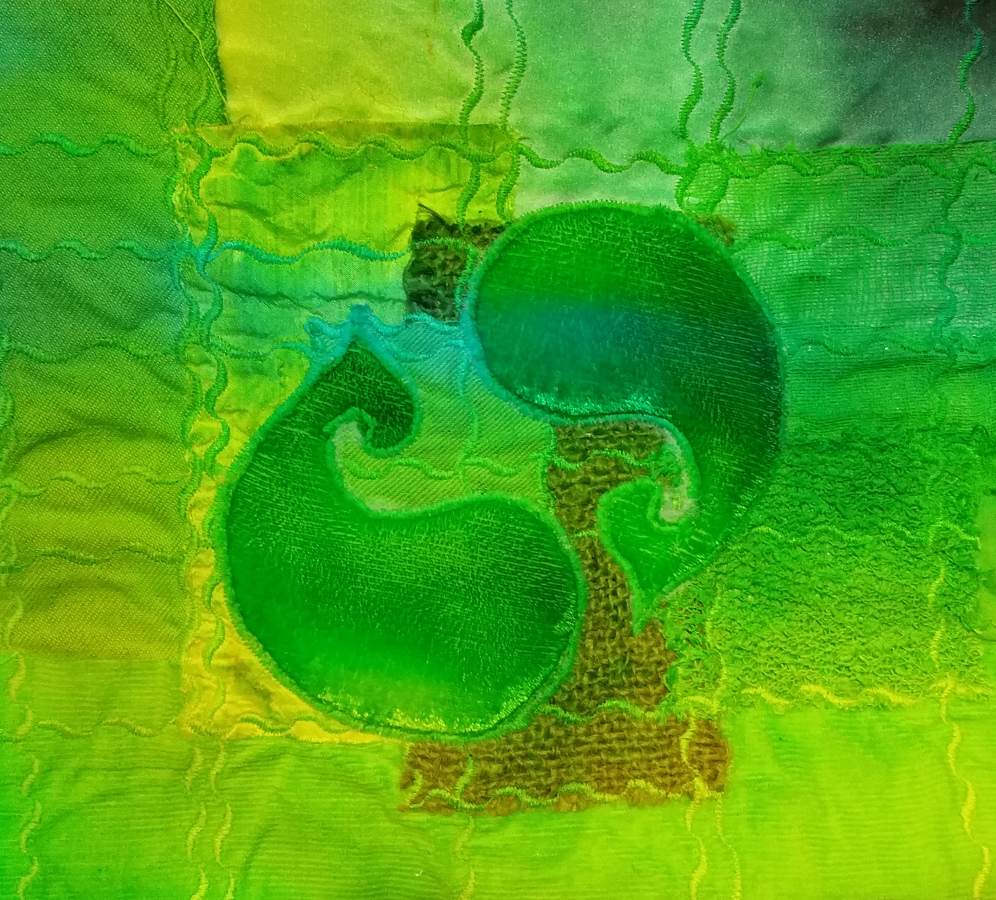 I had a delightful day this week, teaching a textile art workshop to the West Sussex-based Tamarisk Textiles group. What a lovely group to work with – experienced and enthusiastic, and very focussed. The day was based on applique cut-away quilting technique, combined with Procion dyeing (see green sample here). This colour range seemed to catch people’s interest, and about six people chose to work with the combination of very acidic lemon yellow and turquoise, giving a range of greens. I’ll probably add some contrasting stitching to this sample later – maybe in a really different colour like orange or fuschia, or maybe in the darker shades of green already in the piece.
I had a delightful day this week, teaching a textile art workshop to the West Sussex-based Tamarisk Textiles group. What a lovely group to work with – experienced and enthusiastic, and very focussed. The day was based on applique cut-away quilting technique, combined with Procion dyeing (see green sample here). This colour range seemed to catch people’s interest, and about six people chose to work with the combination of very acidic lemon yellow and turquoise, giving a range of greens. I’ll probably add some contrasting stitching to this sample later – maybe in a really different colour like orange or fuschia, or maybe in the darker shades of green already in the piece.
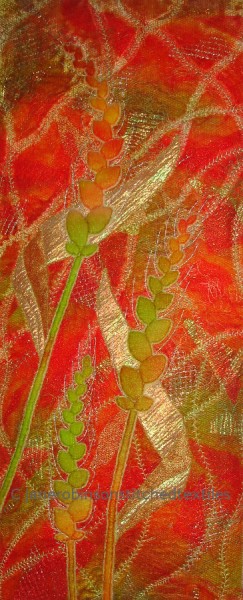 Cut-away applique is as old as the hills, and has been used in many different ways by so many different cultures and embroidery traditions ranging from India to Panama. On the left is a photo of a piece I made donkeys years ago, using cut-away applique (I’ve shown it here before, I forget why). The padded top layer is dyed viscose velvet and the bottom layer is a ‘sandwich’ of different fabrics and threads. Stitching goes through all the layers and is then cut away leaving the top one standing proud of the background. The difference with this one is that I dyed the fabric first, which is why the greens and reds haven’t bled into each other. I did it that way because I didn’t want to blend them and end up with brown. For the blending approach, it’s important to like the colour that you get when your chosen colours bleed into each other.
Cut-away applique is as old as the hills, and has been used in many different ways by so many different cultures and embroidery traditions ranging from India to Panama. On the left is a photo of a piece I made donkeys years ago, using cut-away applique (I’ve shown it here before, I forget why). The padded top layer is dyed viscose velvet and the bottom layer is a ‘sandwich’ of different fabrics and threads. Stitching goes through all the layers and is then cut away leaving the top one standing proud of the background. The difference with this one is that I dyed the fabric first, which is why the greens and reds haven’t bled into each other. I did it that way because I didn’t want to blend them and end up with brown. For the blending approach, it’s important to like the colour that you get when your chosen colours bleed into each other.
At this week’s workshop everything was stitched in white on white, and then dyed at the end. The idea is that the dyes will ‘bleed’ across the different fabrics and react differently with each one. The background is built up with pieced and patched bits of un-dyed fabrics with different textures, which is held in place with decorative stitching in undyed thread. It is all dyed at the end.
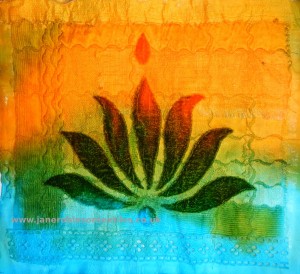 I think I’ll re-dye this yellow and turquoise one, as the turquoise would be better darker – I think it looks abit ‘weak’. The other issue with this one is that a slight bondaweb sheen can be seen through the strip of dyed lace, so I think that would be better hand-stitched into place instead.
I think I’ll re-dye this yellow and turquoise one, as the turquoise would be better darker – I think it looks abit ‘weak’. The other issue with this one is that a slight bondaweb sheen can be seen through the strip of dyed lace, so I think that would be better hand-stitched into place instead.
This purple one was made in a slightly different way. Rather than applying bits of fabric, I layered lots of snippets of thread across a backing fabric, on a layer of bondaweb, and then stitched them down with machine vermicelli free-stitching. I’m not entirely convinced by this one because there’s a slight sheen coming through from the bondaweb (it doesn’t show in the photo and other people say it’s OK, but it annoys me). Deeper layers of threads would solve that, but then they slither around while you stitch over them. This was dyed with turquise and fuschia pink. I haven’t photographed the orange and fuschia pink piece that I made as a demonstration in class as I haven’t rinsed it out yet.
The group produced some lovely work. It was quite a tall order to create the backgrounds, stitch them, apply the padded and raised motifs and get it dyed, all in one day. It could only be done with an experienced group. Some people used my Indian motifs and others created their own. I’m really annoyed with myself for not taking photos of work in progress, and I only remembered to take photos after most of the pieces were packed away. As a result I’ve only got pictures of six pieces of work from the day instead of all 15, but they give an idea of the range of work. I’d be pleased to see some photos of some of the finished pieces when they’re dried and rinsed out. Scroll down for some of the work produced in the workshop.
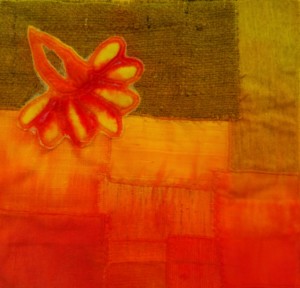
Some nice colour bleeding in the bottom half, where the red has been given freedom to find it’s own way into the yellow. (student’s work).
The Scriptorium
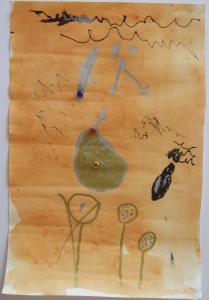
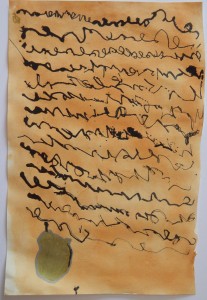 There is now a Scriptorium in our house, created by two brave young Knights from Vienna aged 11 and 6. The Scriptorium is an inner santum of the house where a secret password is needed for anyone to enter. The Knights have been commanding their brave army and fighting off thousands of warriors that were trying to attack from the back of our garden. Phew, we’re saved!
There is now a Scriptorium in our house, created by two brave young Knights from Vienna aged 11 and 6. The Scriptorium is an inner santum of the house where a secret password is needed for anyone to enter. The Knights have been commanding their brave army and fighting off thousands of warriors that were trying to attack from the back of our garden. Phew, we’re saved!
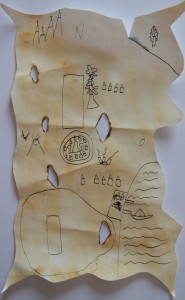
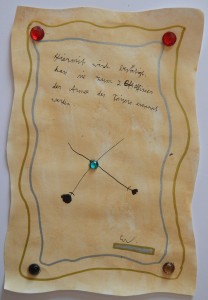 Then in the Scriptorium, the Knights and Queen Jane write treaties and draw maps to secure the peace. A special feather pen is used for the writing, which the Knights got from their recent visit to the Tower of London. Here’s a map of the Kingdom on the left, showing mountains, a forest, volcanoes, sea, a windmill, a village and secret treasure.
Then in the Scriptorium, the Knights and Queen Jane write treaties and draw maps to secure the peace. A special feather pen is used for the writing, which the Knights got from their recent visit to the Tower of London. Here’s a map of the Kingdom on the left, showing mountains, a forest, volcanoes, sea, a windmill, a village and secret treasure.
On the left you can see the story of the battle between dark and light, and how the Knights re-established the Yin and Yang of balance. I’m glad to say we’re been saved from darkness.
The old paper was made from Khadi paper soaked in tea, and leather parchment was made from scrumpled tissue paper and PVA glue, soaked in tea. I always knew that the City and Guilds Embroidery course would come in handy!
Apologies for the delay since my last post, but I’m sure you’ll understand that important international treaties have to take priority. I’ll return to my blog some time in the next week or so when I’ll update you with photos of our exhibition in May, and the Worthing Open Houses which finished a couple of weeks ago. In the meantime, back to important treaties to secure peace and harmony.
‘FIVE’ Exhibition is now open

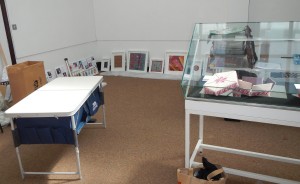
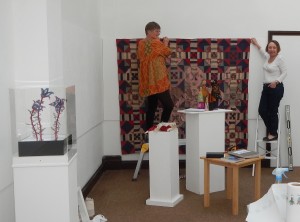
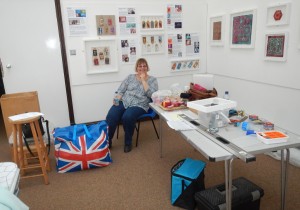
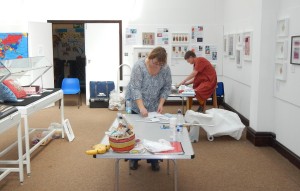 The ‘FIVE’ exhibition is now installed in Worthing. I’ve ‘disappeared’ from my blog for a while because of preparations for the exhibition, so I’m pleased to say it’s all hung and open to visitors now. There’s one photo above of a finished section, and I’ll add more photos of the final installation when I’ve taken some in better light.
The ‘FIVE’ exhibition is now installed in Worthing. I’ve ‘disappeared’ from my blog for a while because of preparations for the exhibition, so I’m pleased to say it’s all hung and open to visitors now. There’s one photo above of a finished section, and I’ll add more photos of the final installation when I’ve taken some in better light.
In the meantime, here are some photos of ‘work in progress’ while we were hanging the work. We did have a few ‘headless chicken’ moments, but we were OK once we’d worked out a ‘grand plan’ of what was going where before getting down to details. There’s so much to organise in advance, down to the minutest details like the size and length of screws needed, where to source plinths from, publicity and writing Artist Statements etc. Working out a ‘house style’ was well worth the time invested, to give some continuity for labels etc.
The ‘team’ all stayed at my house during the 3 days of installation as I’m the only one local to the exhibition. I have to admit, by the time we were kicked out of the gallery each day at closing time we were ready for a glass of wine or three. My husband is now convinced that textiles are just a ‘cover’ for an eating and drinking group. Mind you, having just taken out the recycling I can see why he thinks that!
We’re at The Studio Gallery at Worthing Museum and Art Gallery, Chapel Road, Worthing BN11 1HP. If you’re planning to come over, then a good time to come would be this Saturday, 14th May between 2 and 5pm. That’s the one time when all five of us will be there so we’d love to see you then. Otherwise, we’re open until May the 21st, from Tuesday-Saturday, 10.00am to 5.00pm. Do come to see us if you can. Here’s a sneak preview below of part of the room in a panoramic shot.
Bling
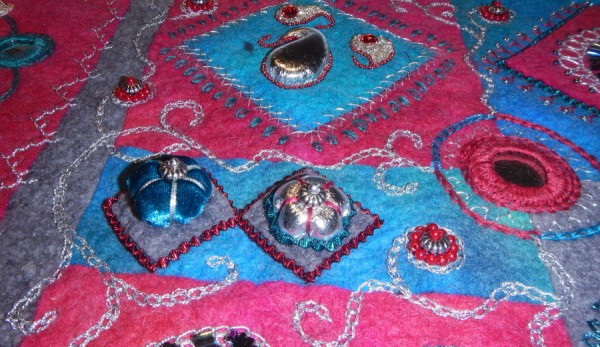 There’s something about the sparkle of metal thread that keeps drawing me back to it. Perhaps I was a magpie in a former life? Here’s an update on the piece that I was working on some time ago, based on motifs from Indian textiles.
There’s something about the sparkle of metal thread that keeps drawing me back to it. Perhaps I was a magpie in a former life? Here’s an update on the piece that I was working on some time ago, based on motifs from Indian textiles. 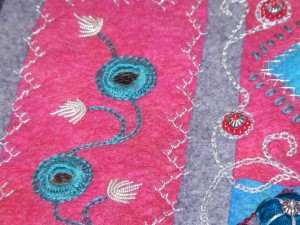 I’ll just show you some details rather than the whole finished piece, because it will be going into our exhibition in May – but once it is up on the wall then I’ll post pictures of the finished thing. I’m working on several other pieces alongside it, but this particular one has been quite time-consuming so it’s good to see it finally coming together. I really wanted to do something that was purely decorative and not ‘conceptual’ in any way. I prefer not to use an embroidery hoop where I can avoid it, so working on thick felt makes that easier as it isn’t too floppy. Unfortunately it makes it hard to photograph. Something about the way felt absorbs light seems to drain the colour out of the photo, so it either looks dull or harsh. The colours are better in real life, honest! I’ll post some of the other pieces that I’m working on in another post quite soon.
I’ll just show you some details rather than the whole finished piece, because it will be going into our exhibition in May – but once it is up on the wall then I’ll post pictures of the finished thing. I’m working on several other pieces alongside it, but this particular one has been quite time-consuming so it’s good to see it finally coming together. I really wanted to do something that was purely decorative and not ‘conceptual’ in any way. I prefer not to use an embroidery hoop where I can avoid it, so working on thick felt makes that easier as it isn’t too floppy. Unfortunately it makes it hard to photograph. Something about the way felt absorbs light seems to drain the colour out of the photo, so it either looks dull or harsh. The colours are better in real life, honest! I’ll post some of the other pieces that I’m working on in another post quite soon.
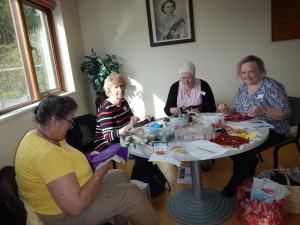
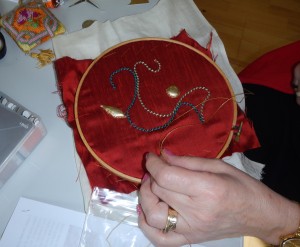 On the subject of bling, I ran a day workshop on goldwork last week for the West Sussex Federation of Women’s Institutes. They have regular craft days that are open to all the different local branches. It’s an opportunity to get together and learn something – and yes, some stitching did go on in between the chatting! I enjoyed teaching such a friendly and welcoming group, and their enthusiasm was lovely. I offered the choice of working from my design, or ‘going off-piste’ and working more spontaneously. Three people chose to work from the design and nine chose to work spontaneously. I have seen people getting quite stressed with goldwork because of the emphasis on ‘perfection’ and the difficulty of achieving that in the early stages. It’s hard to try to produce something perfect when you’re learning the techniques, and the traditional plain silk backing really emphasises any little mistakes. The idea of doing it more ‘free-form’ is to let the materials dictate the shapes, so that there is no ‘right or wrong’ place to position each piece. As I explained, the design did not need to be any more challenging than starting with a zig-zag or a wiggle, then letting those develop to complement the first lines, and then filling in spaces. Several people produced pieces that looked quite ‘art nouveau’ in their shapes, because they let the materials ‘flow’ quite naturally.
On the subject of bling, I ran a day workshop on goldwork last week for the West Sussex Federation of Women’s Institutes. They have regular craft days that are open to all the different local branches. It’s an opportunity to get together and learn something – and yes, some stitching did go on in between the chatting! I enjoyed teaching such a friendly and welcoming group, and their enthusiasm was lovely. I offered the choice of working from my design, or ‘going off-piste’ and working more spontaneously. Three people chose to work from the design and nine chose to work spontaneously. I have seen people getting quite stressed with goldwork because of the emphasis on ‘perfection’ and the difficulty of achieving that in the early stages. It’s hard to try to produce something perfect when you’re learning the techniques, and the traditional plain silk backing really emphasises any little mistakes. The idea of doing it more ‘free-form’ is to let the materials dictate the shapes, so that there is no ‘right or wrong’ place to position each piece. As I explained, the design did not need to be any more challenging than starting with a zig-zag or a wiggle, then letting those develop to complement the first lines, and then filling in spaces. Several people produced pieces that looked quite ‘art nouveau’ in their shapes, because they let the materials ‘flow’ quite naturally.
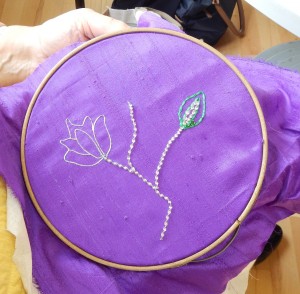 Working like that isn’t everyone’s cup of tea, and I did explain that it was abit of an experiment, but I was impressed that so many were willing to give it a go. The people who worked from a design also produced some pleasing results.
Working like that isn’t everyone’s cup of tea, and I did explain that it was abit of an experiment, but I was impressed that so many were willing to give it a go. The people who worked from a design also produced some pleasing results.
Now I must focus on finishing off the half-done pieces for the exhibition in May. Just to remind you, it’s from Fri 6th May to Sat 21st May (Tuesday to Saturday) 10.00 to 5.00, at The Studio Gallery at Worthing Museum and Art Gallery. See the ‘FIVE’ page on this website for more details.











